Marketing isn’t easy.
We’re all facing marketing challenges due to financial constraints, rapid AI advancements, and quickly changing consumer behaviors.
But the best businesses are adapting. And you can, too.
Keep reading as we walk through current marketing challenges and how you can overcome them.
9 Marketing Challenges and How to Address Them
1. Generating Quality Leads
Generating enough high-quality leads to support organizational goals is one of the biggest challenges marketers face. Because many tactics (like paid ads) lead to diminishing returns over time.
There are also platform updates to consider.
For example, Google regularly fine-tunes its search algorithms in ways that can affect your visibility in search results.
Just look at how much volatility the Semrush Sensor detected in the weeks surrounding the March 2023 core update.
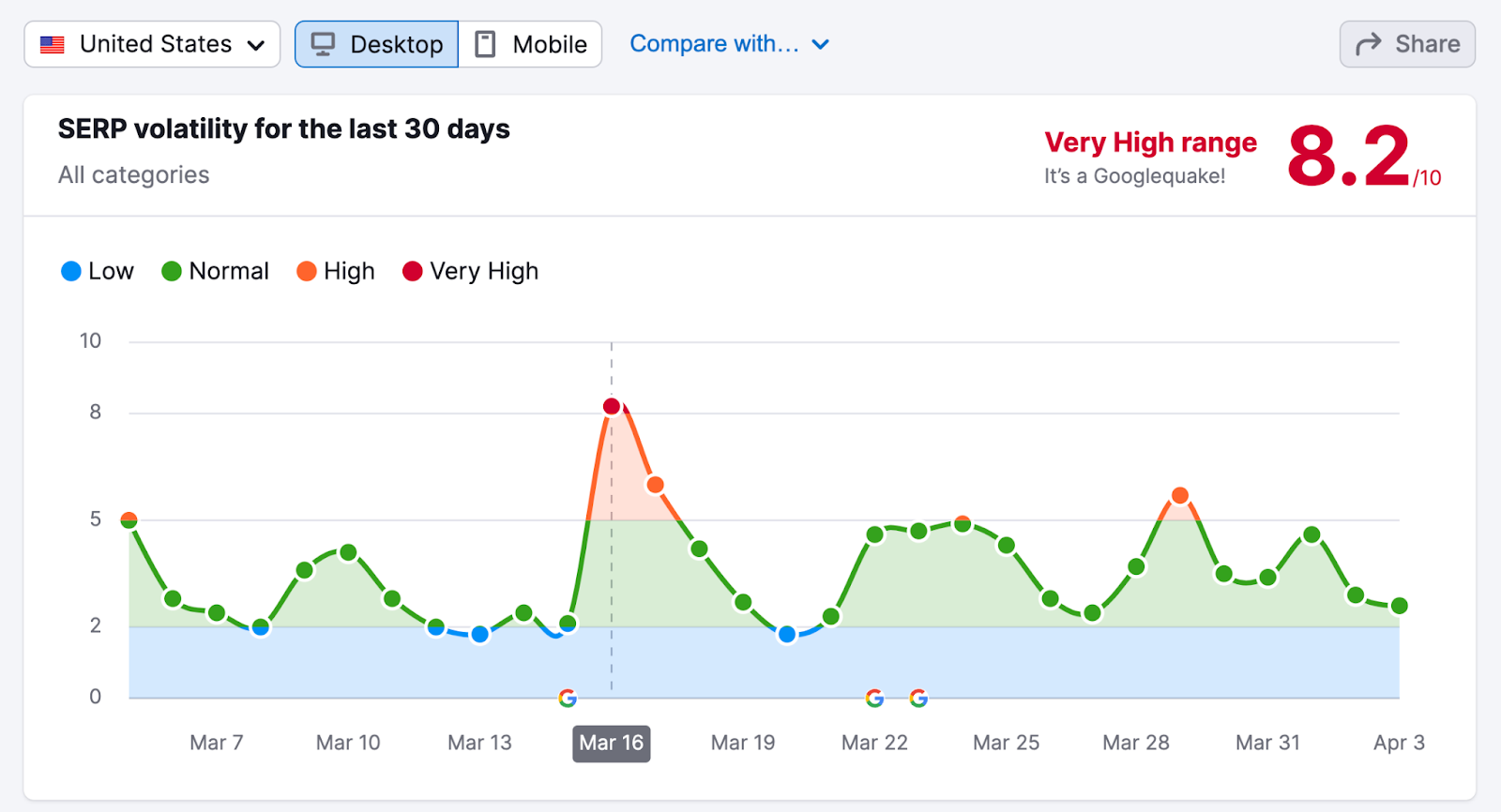
This can drastically impact whether prospects will see your conversion-focused content.
And Meta similarly rolls out updates that affect both the organic (meaning unpaid) social posts and social ads users see.
All of these can lead to you needing to invest more in your marketing efforts to drive leads who are likely to become customers.
How to Solve This Problem
One good way to generate high-converting leads is by creating and distributing quality content across multiple marketing channels.
This helps you reach more people. And reduce the risk of any single channel negatively impacting you too much.
For help creating search-optimized content, you can use Semrush’s SEO Content Template. This tool automates the first step in the content creation process by generating SEO content briefs.
First, type in your target keyword(s), choose a target geography, and click “Create content template.”

Semrush then analyzes the top-10-ranking search results for your target keyword(s).
You’ll then see recommendations to help you outrank your competitors. For example:
- A list of related keywords
- A list of backlink opportunities
- A recommended readability score
- A suggested text length
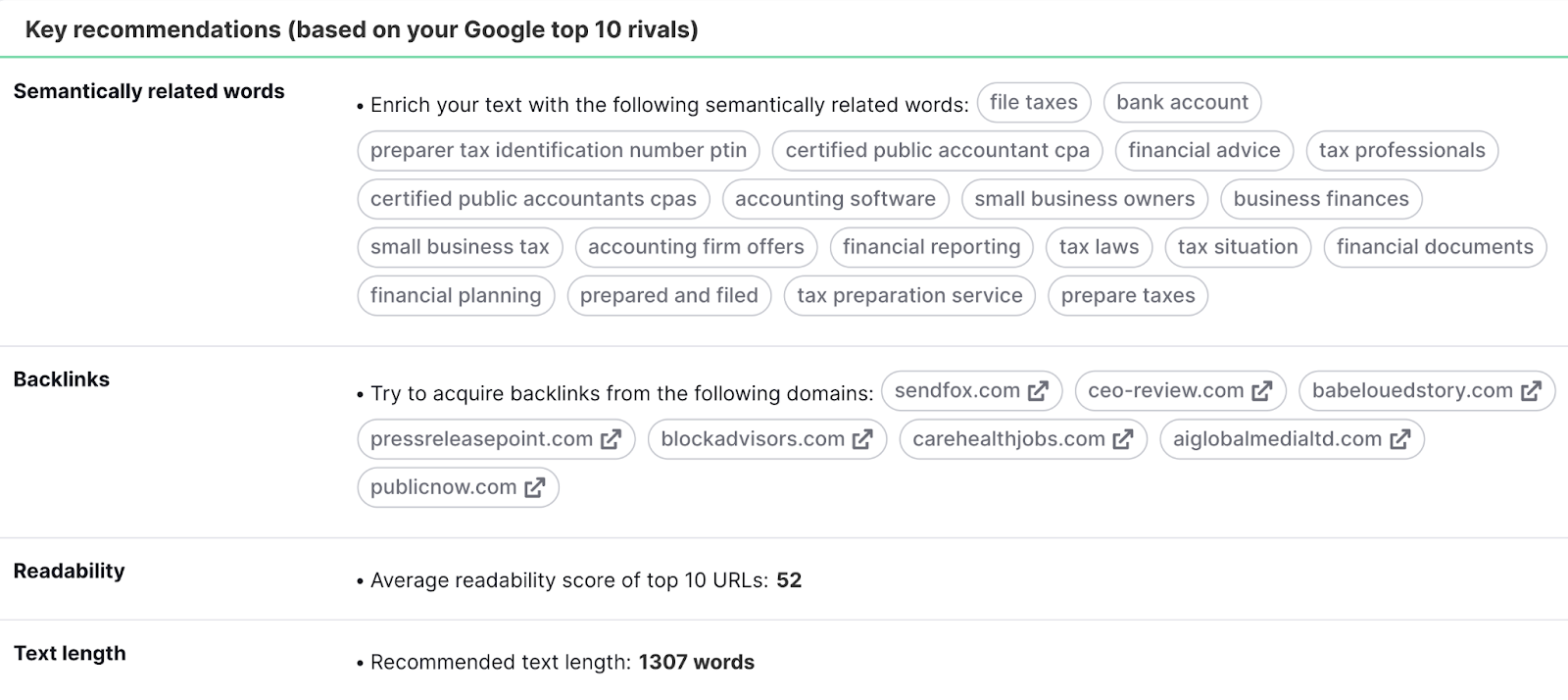
The tool also shows you examples of how your competitors use keywords. To give you inspiration.
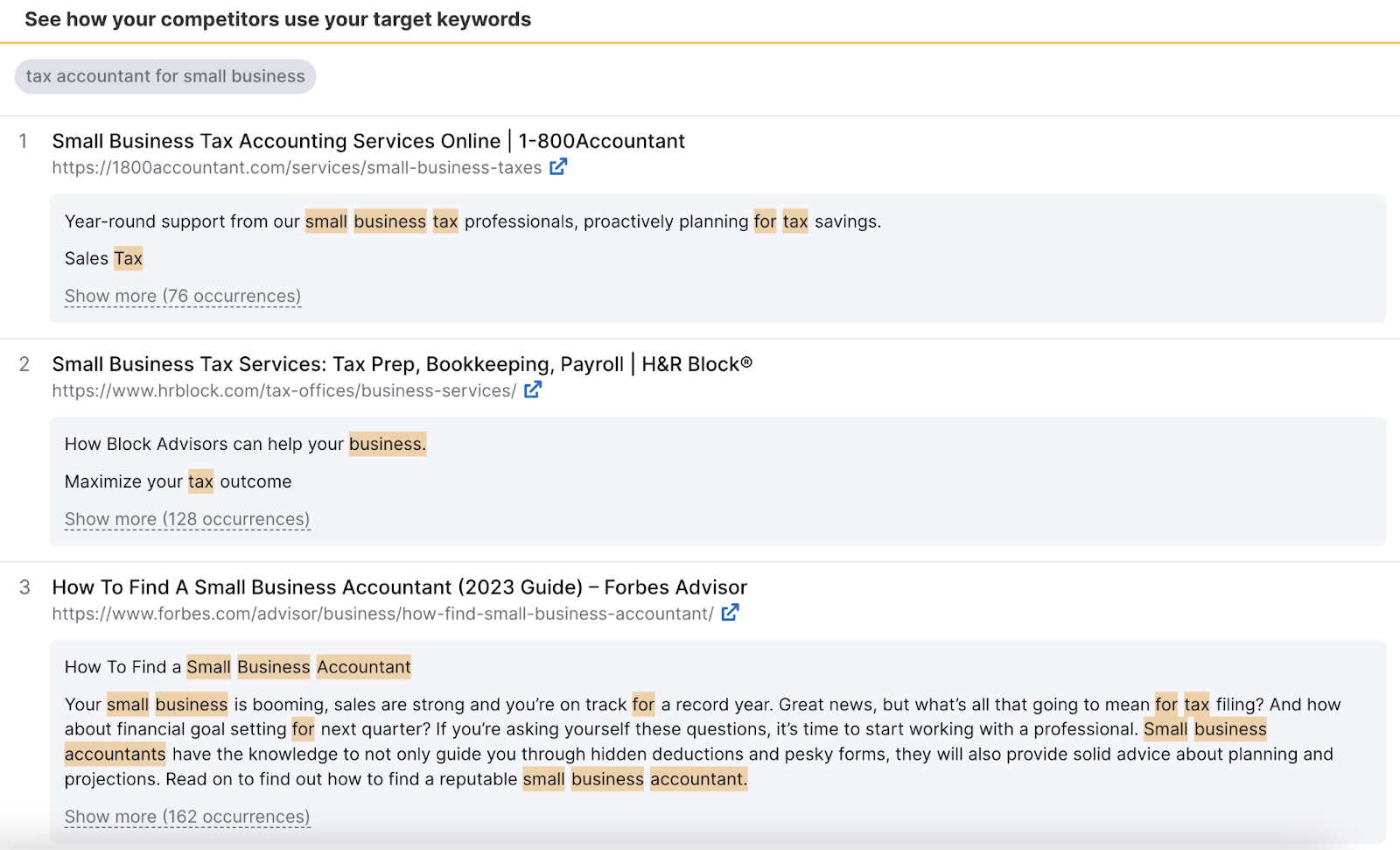
Scroll down to the bottom to see basic recommendations related to your page title, meta description, and more.
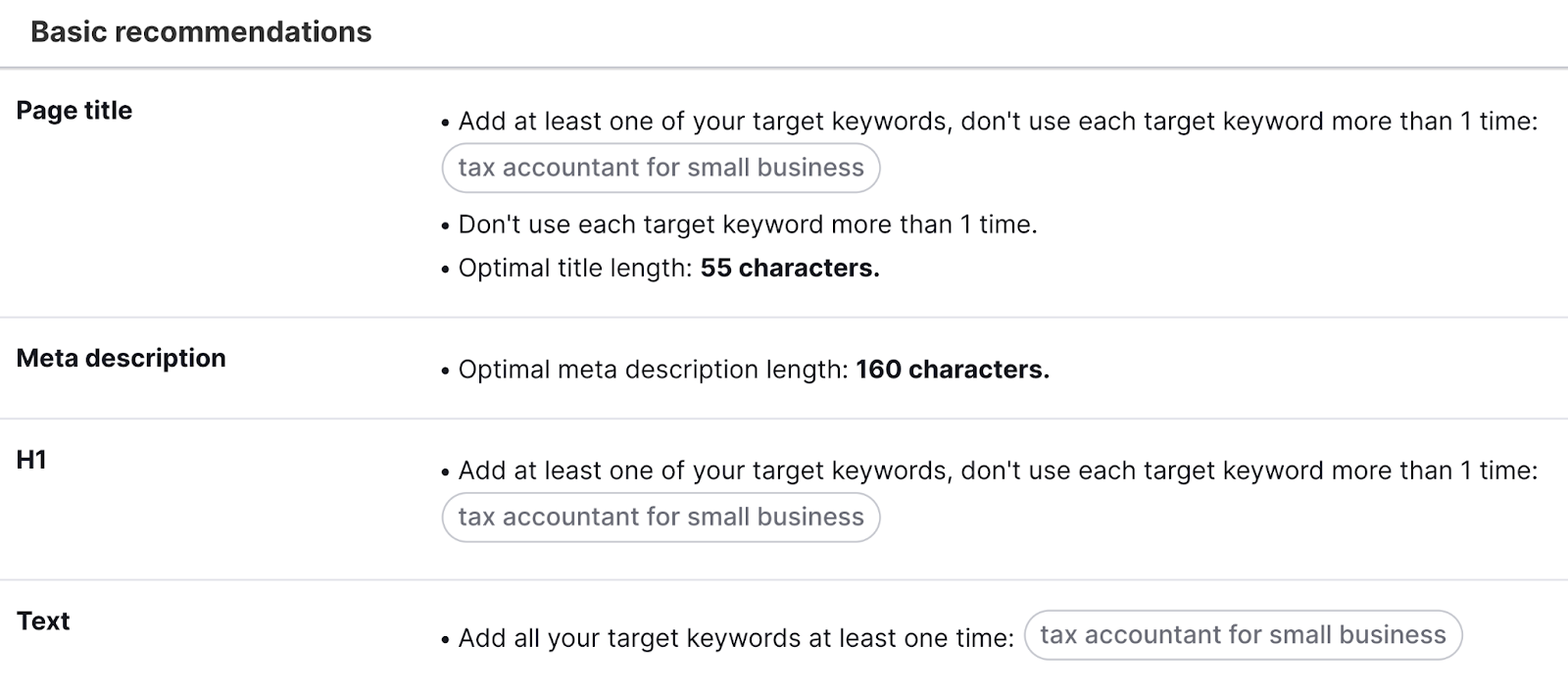
With this content brief, you can now write a high-quality piece designed to rank well on search engines.
Plus, you can distribute the completed content piece across other channels like social media platforms and emails. To appear in front of more potential customers.
2. Adapting to New AI Tools
Business leaders know that AI tools like ChatGPT and Midjourney are able to create copy, images, and videos quickly and inexpensively. Meaning marketers are now feeling the pressure of having to keep up with all the advances in these tools as they use them in their day-to-day work.
This is difficult for a few reasons.
First, marketers need to keep up with the growing list of state-of-the-art tools. And stay on top of the changes that roll out across the ones they already know about.
Like when OpenAI announced that ChatGPT is now able to browse the internet.
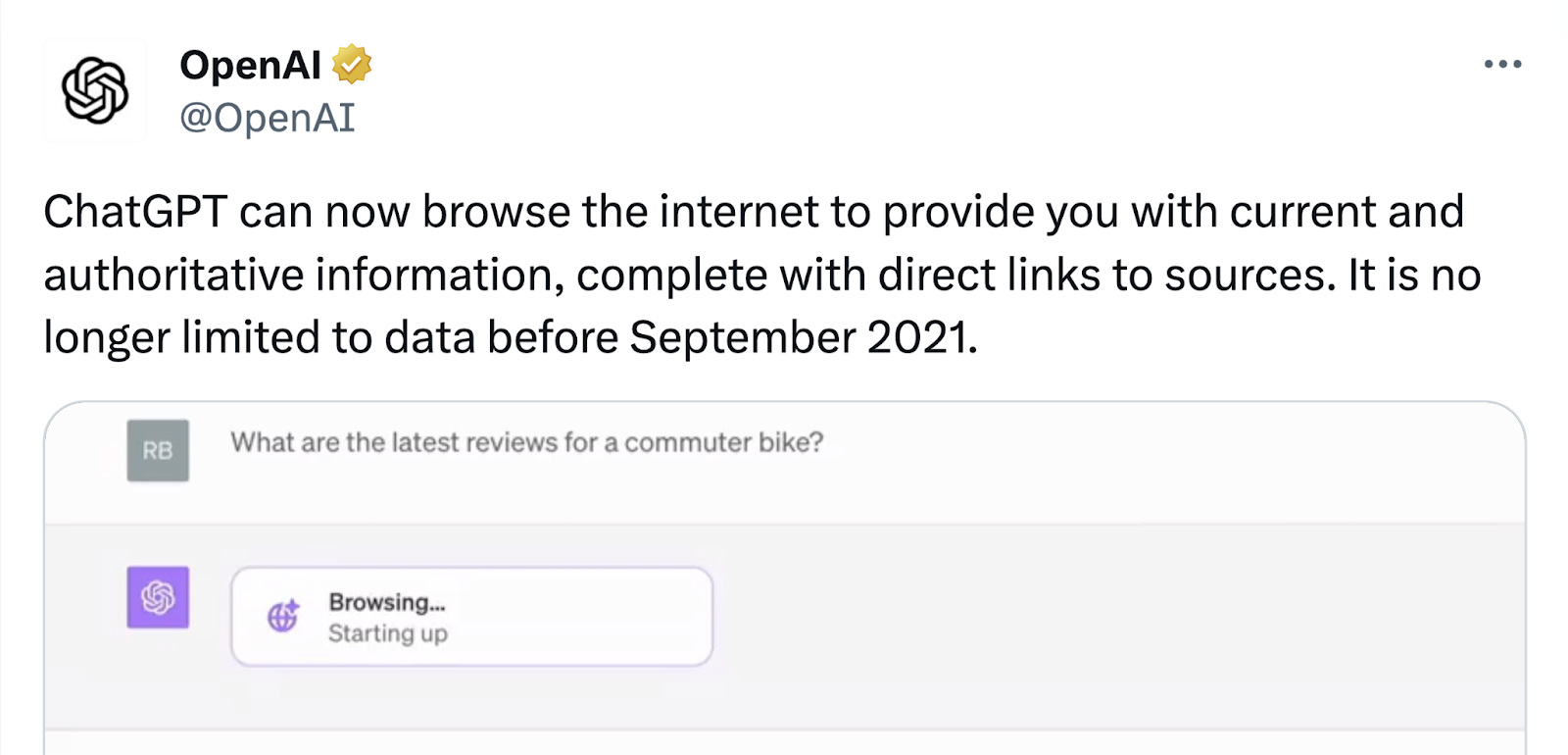
Second, marketers need to figure out the best way to apply AI to their work to reduce costs without losing quality.
For example, Google has warned that while using AI is not against their guidelines, it shouldn’t be used as a cheap method to create low-quality content.
And Google has clearly stated they will preferentially rank high-quality original content. So, marketers risk losing search rankings if they use AI incorrectly.
How to Solve This Problem
Discover reputable AI tools in our App Center. They’re useful for a wide range of marketing tasks.
For example, AI Social Content Generator lets you quickly create social media posts from your existing blog posts.
Open the tool and click the “Create New” button on the right-hand side at the top of the page.
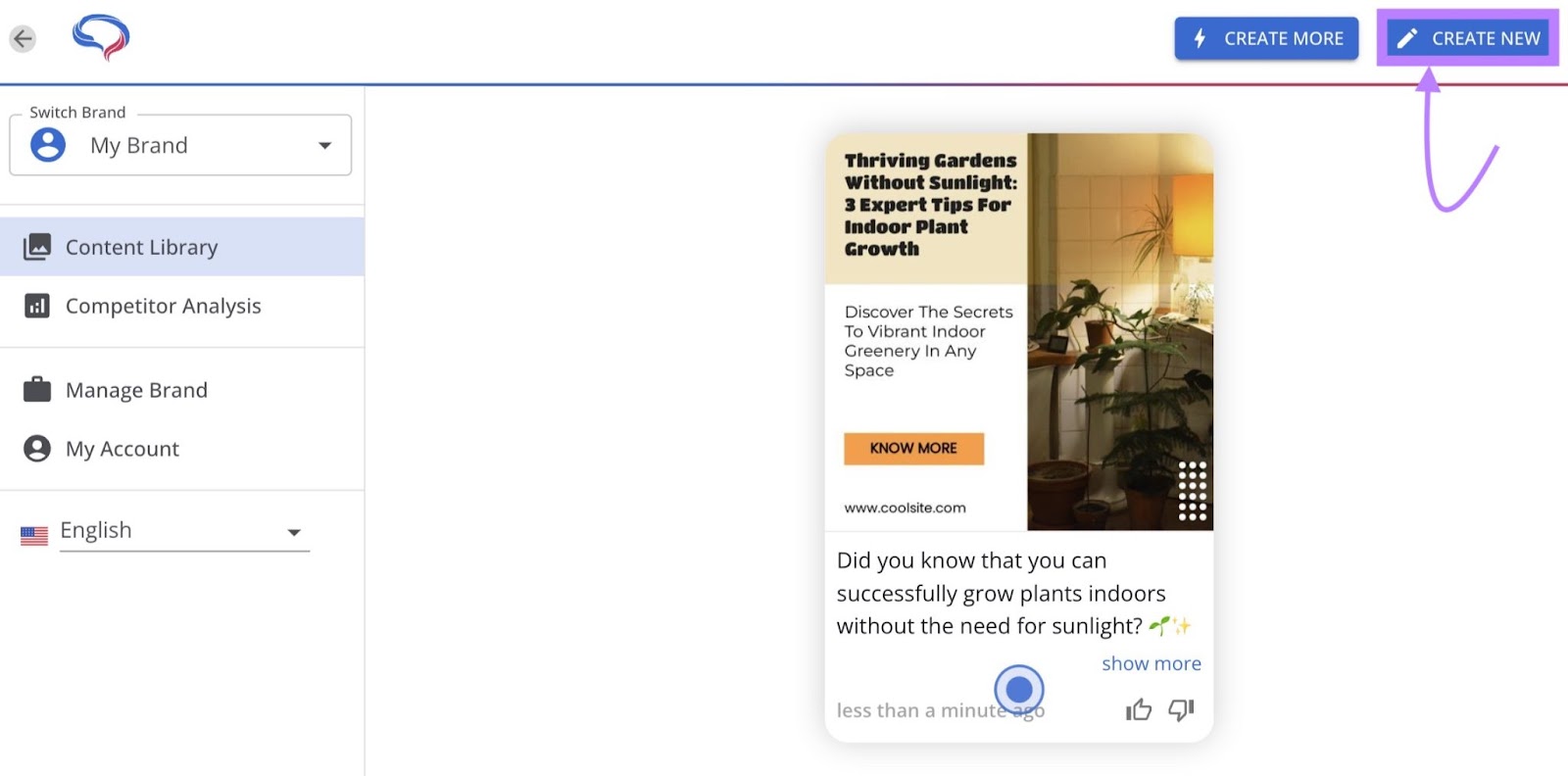
Then, select the “Blog to Post” module.
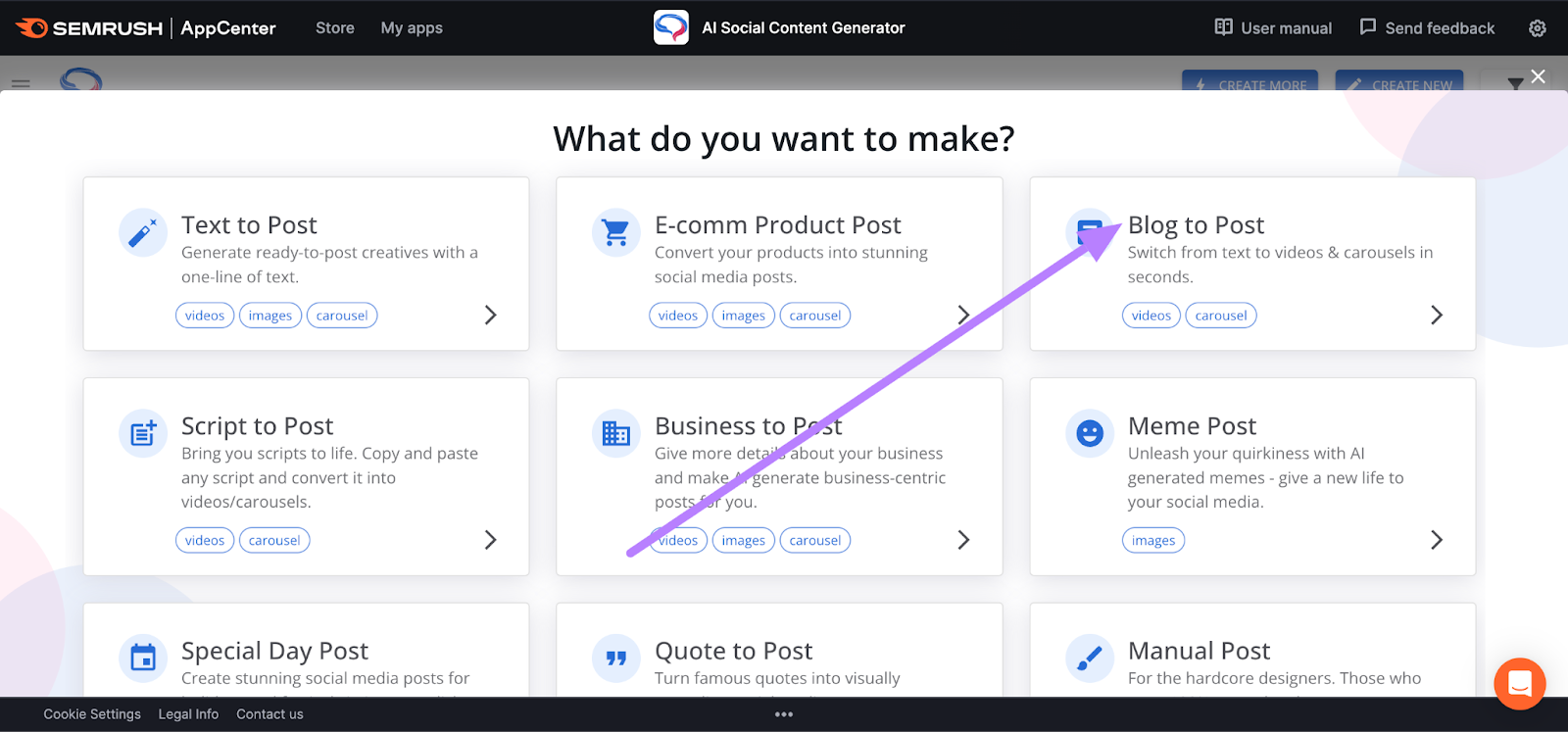
You can now copy and paste your blog post’s URL in the available field and click “Submit.”

The AI tool automatically creates copy based on your blog post. And you’re able to edit the text to further customize it.
Then, click “Confirm.”
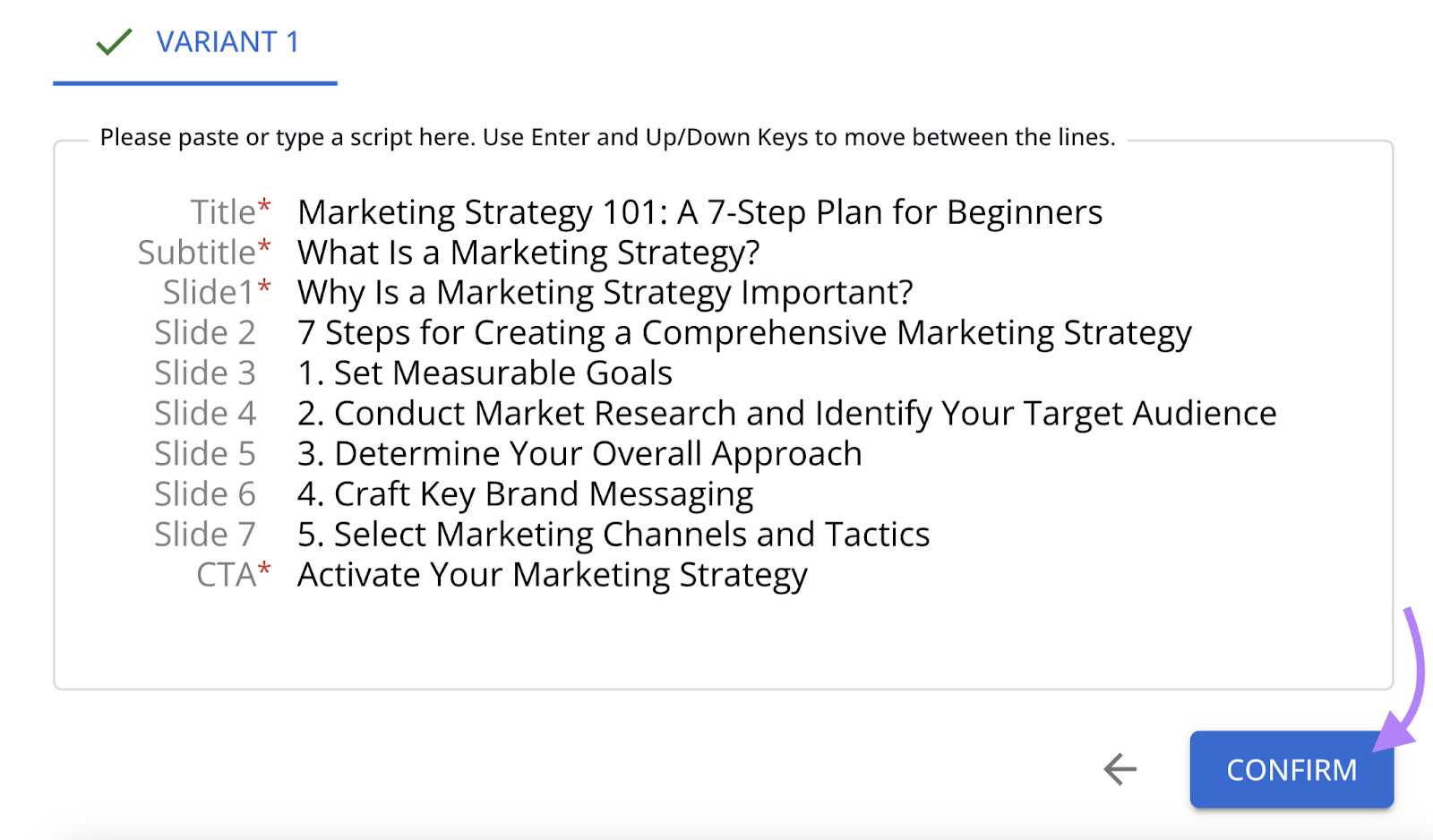
You’ll then click “Next.”
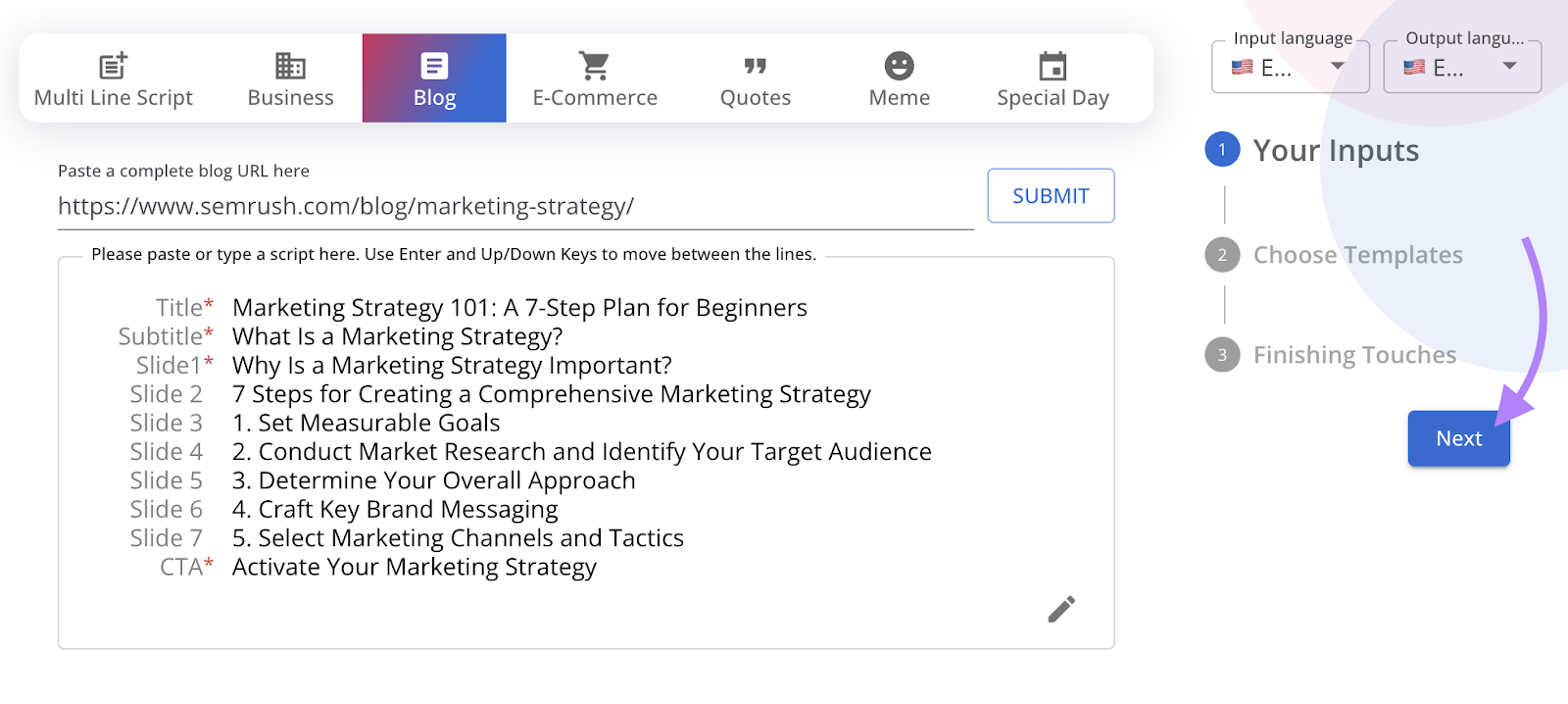
In the next step, choose a template based on the format you want to use. And click “Next.”
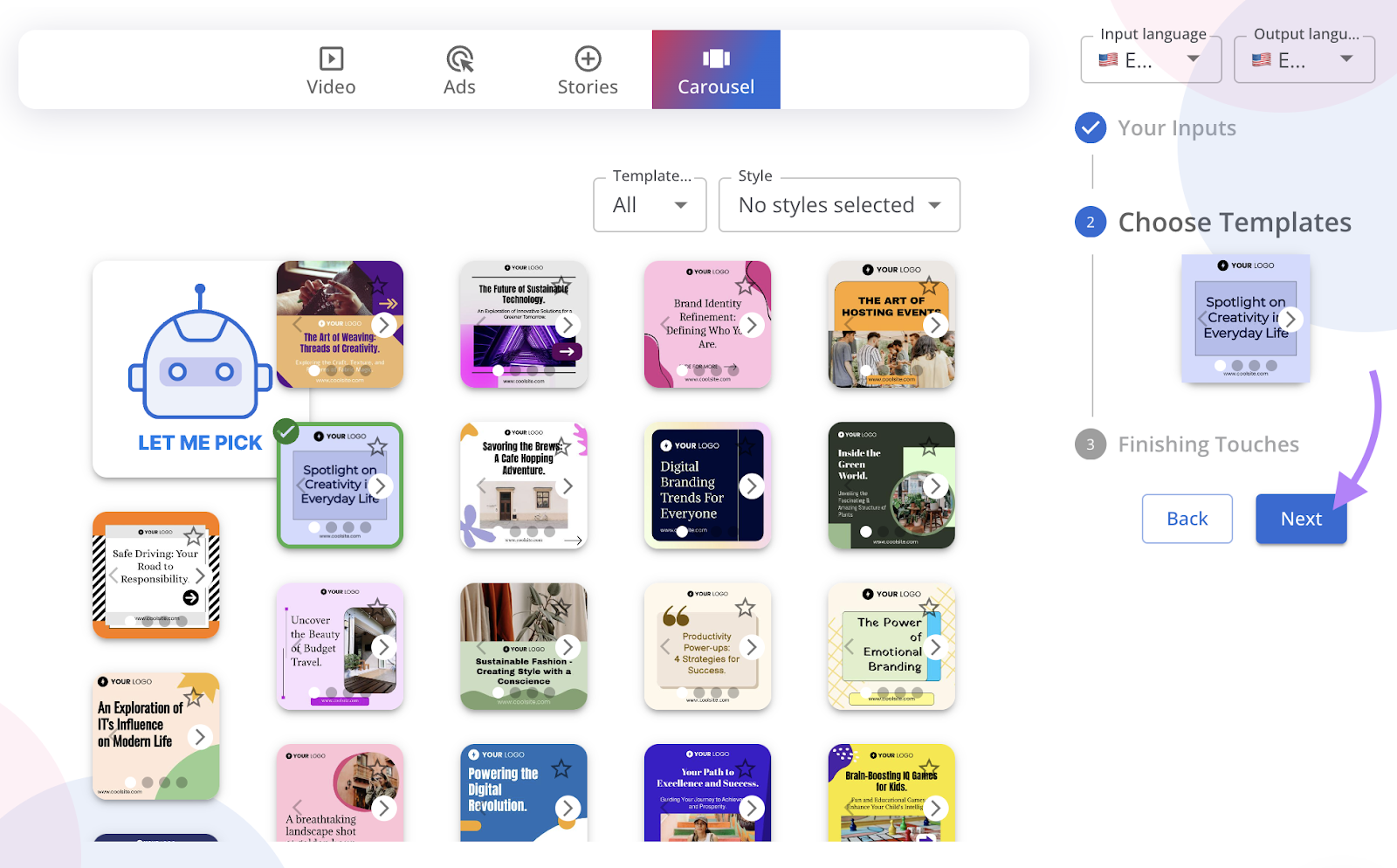
You can then let the tool choose assets for you. Or, you can use your own images or the ones from the blog post.
Then, click “Generate.”
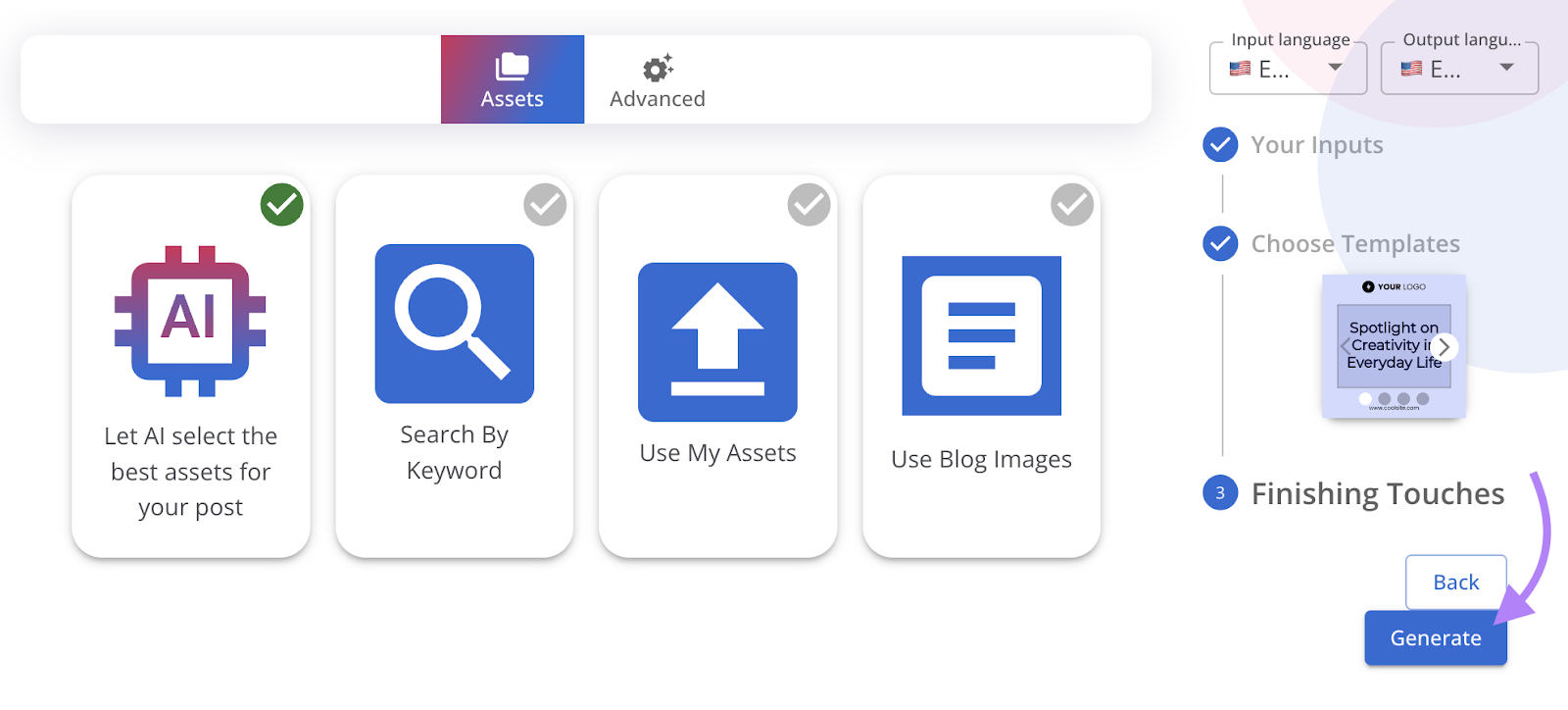
The tool then allows you to edit the post by clicking the pencil icon. And modifying the copy, imagery, etc.
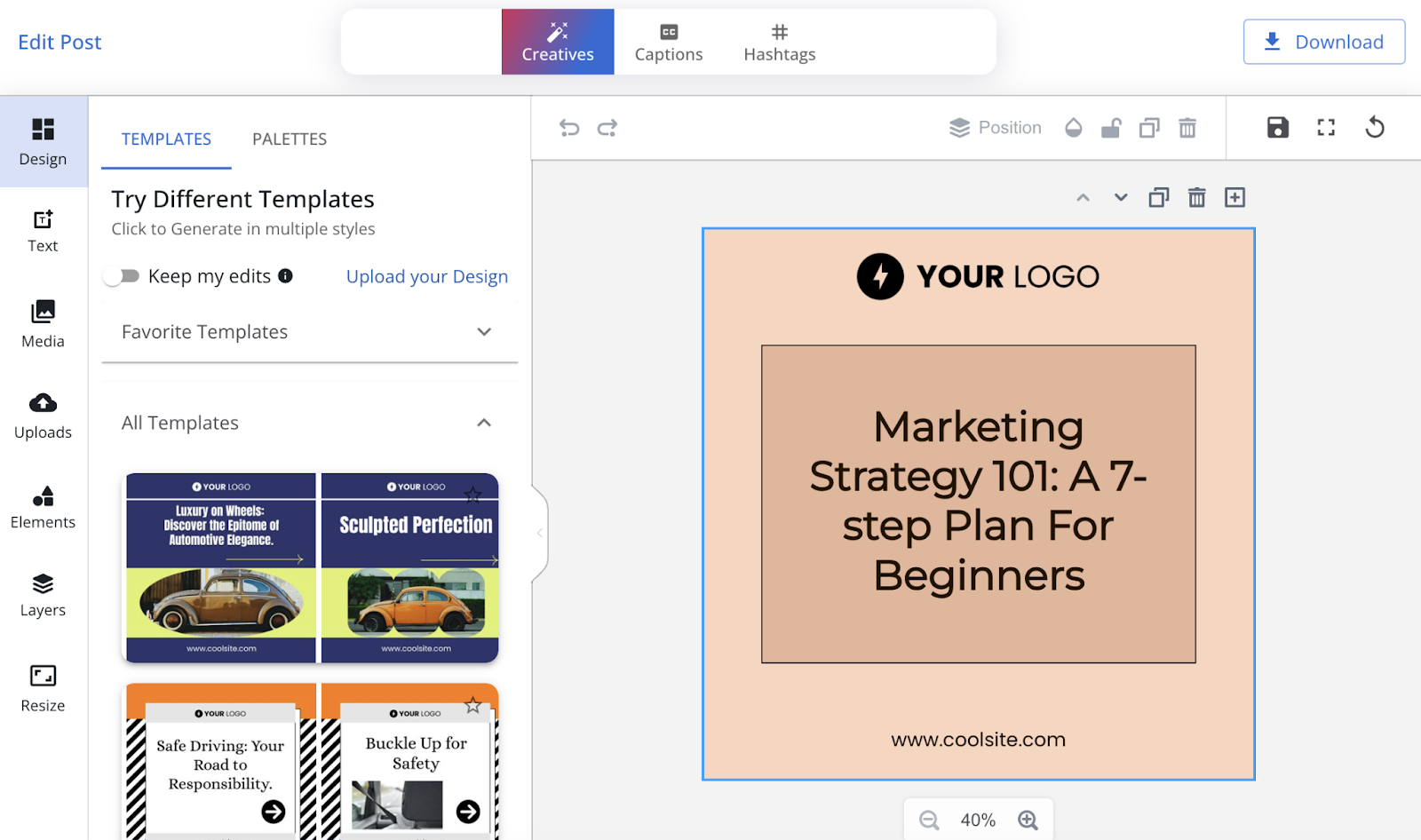
When you’re done making changes, you can download the finished social post to share on the appropriate platform(s).
3. Increased Competition
Nearly every business faces growing competition as others realize they could provide what those customers are looking for. Which means it can be difficult to stand out.
Just consider how easy it is for competitors to look at the ads you’re running.
Meta’s Ad Library lets you view any advertisers' marketing campaigns across Meta.
Here’s an example:
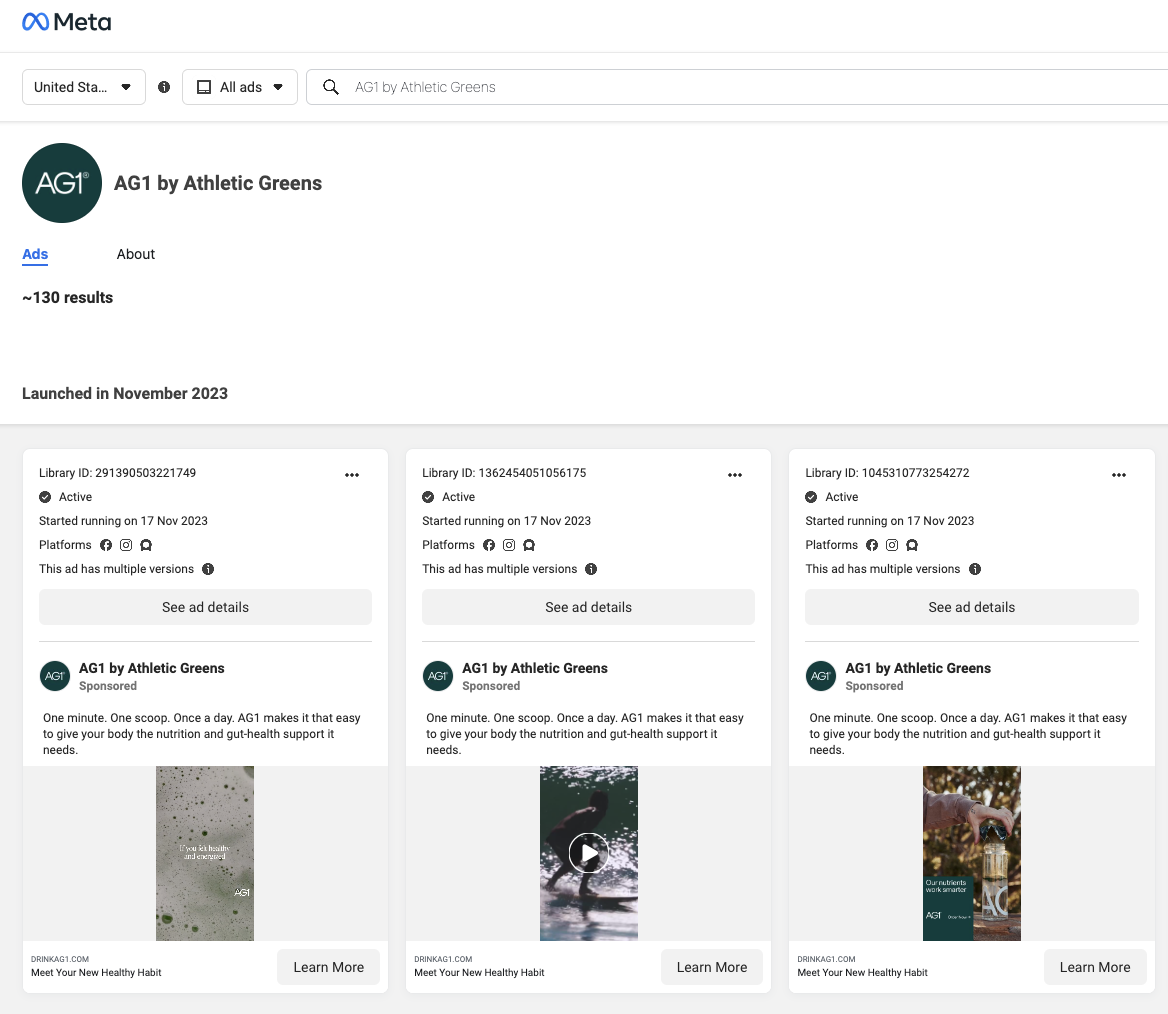
And Google launched something similar called Ads Transparency Center in March 2023.
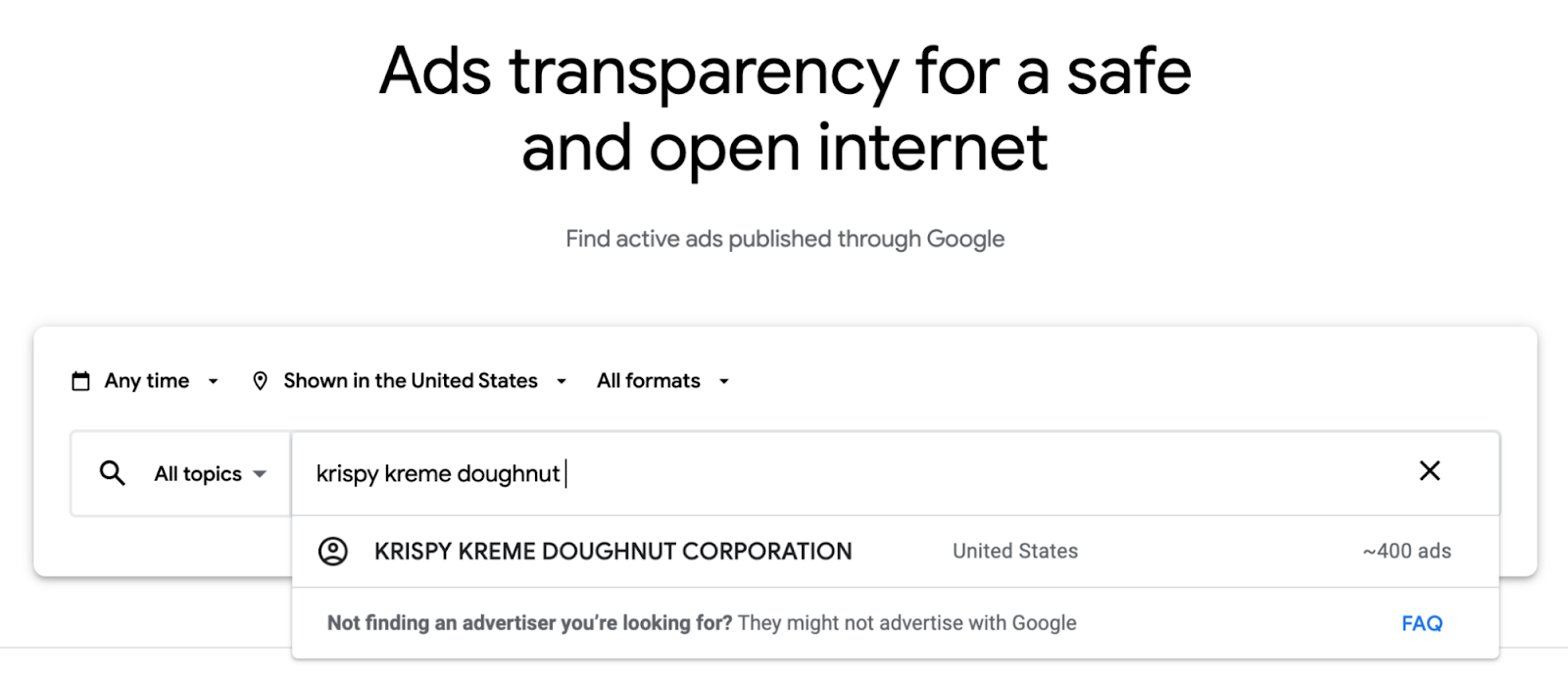
Competitors can use this tool to take a look at the ads you’ve published through Google.
When your competitors are able to so easily see exactly what you’re doing, it can be tricky to show prospective customers what makes you unique.
How to Solve This Problem
You stand a better chance of success by focusing your marketing efforts on a specific niche—meaning a particular segment of your target audience. Because it helps you speak to their specific needs.
Focusing on a smaller audience can even help you reduce your budget.
But how do you know which audience to focus on?
Use Semrush’s One2Target tool to identify some key groups you can focus on.
First, choose a location.
Then enter up to five competitors’ domains. And click “Analyze.”
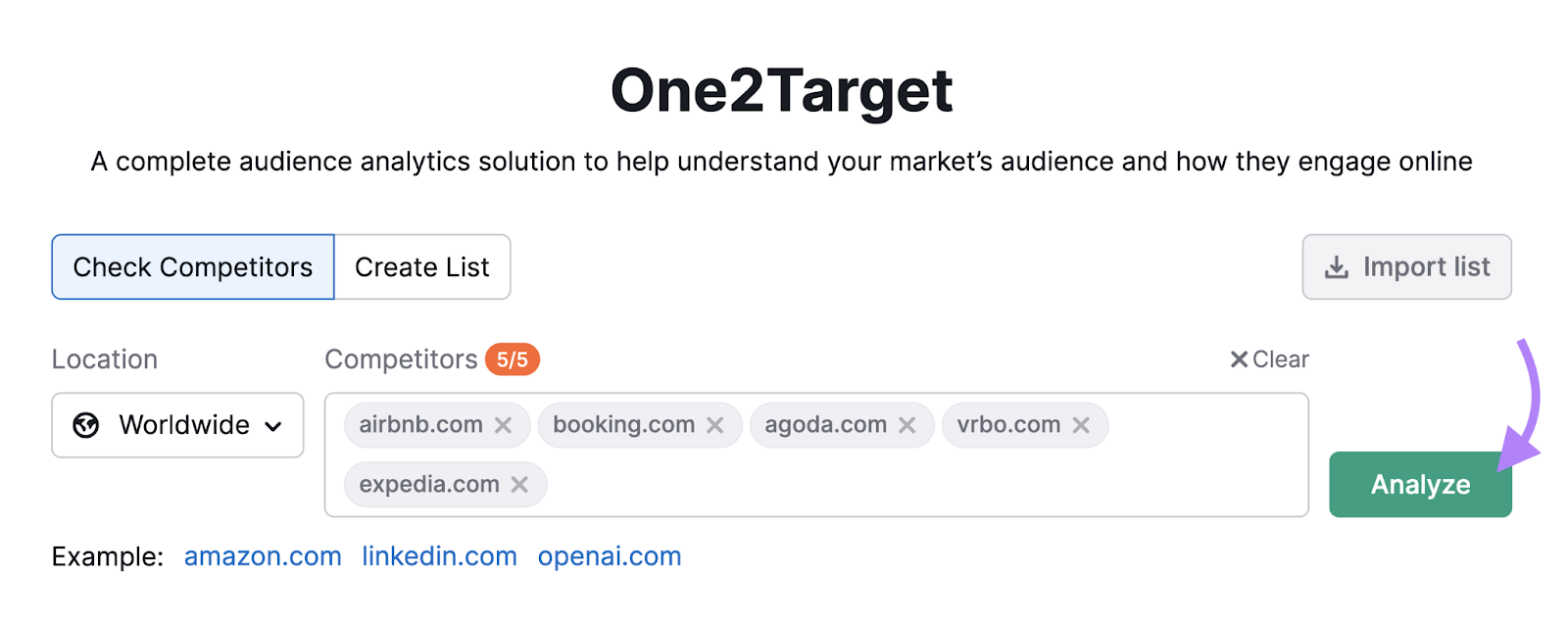
In the “Demographics” report, you’ll see an overview of the audience’s age, country, and more.
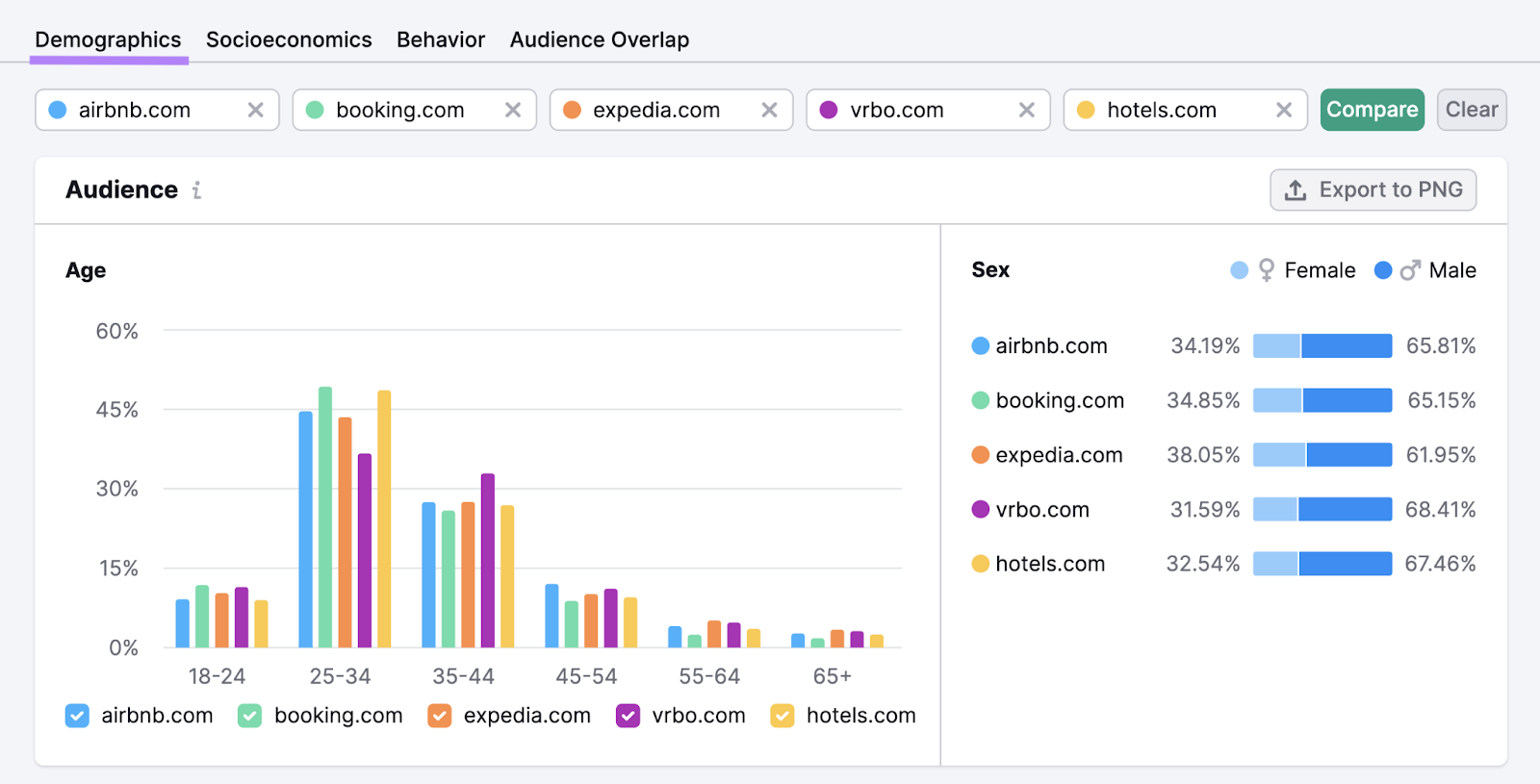
Next, go to the “Socioeconomics” tab. Here, you can see the audience’s household size, income bracket, employment status, and education level.
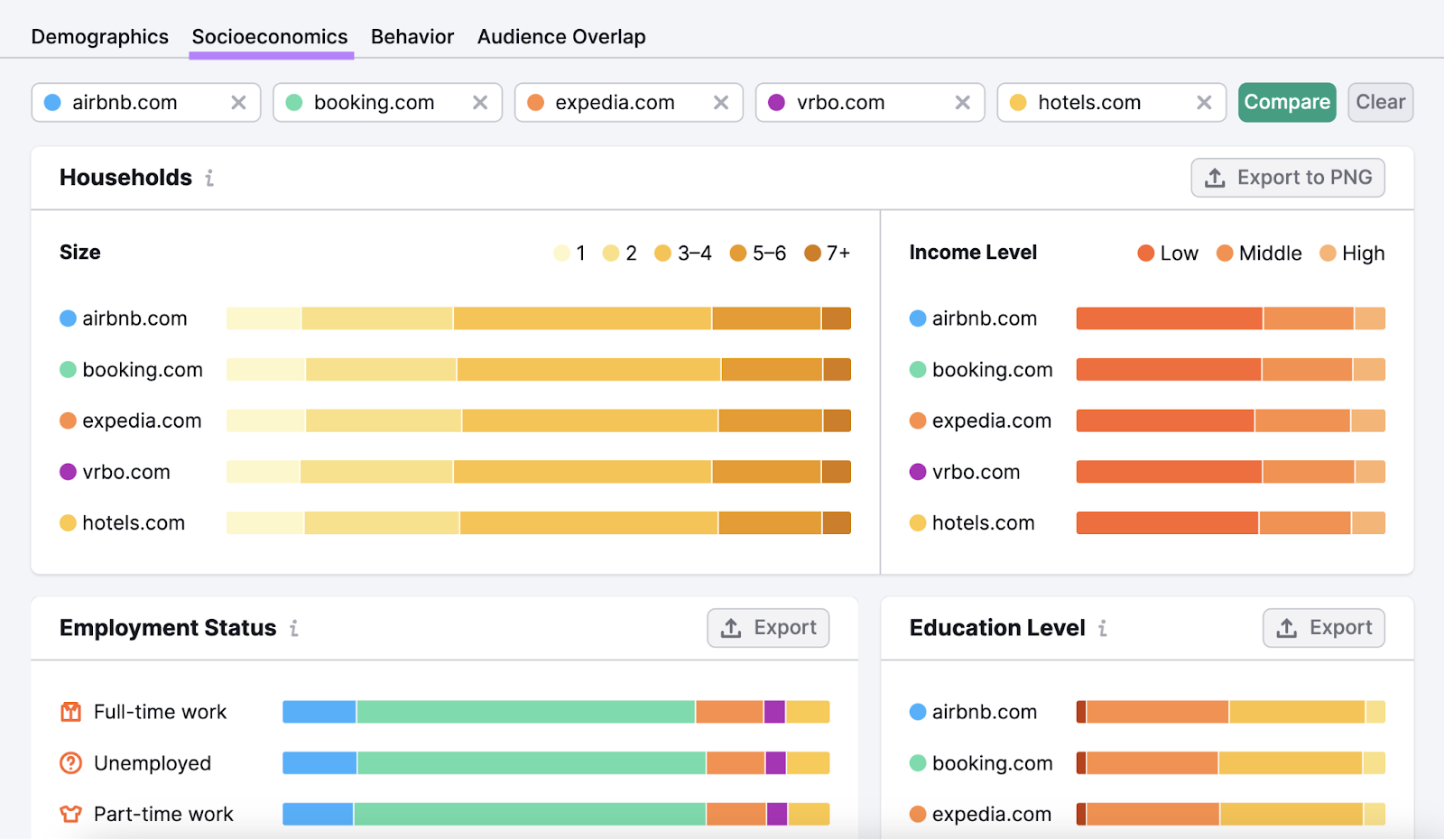
Go to the “Behavior” tab to discover the audience’s interests, device preferences, and frequently used social media platforms.
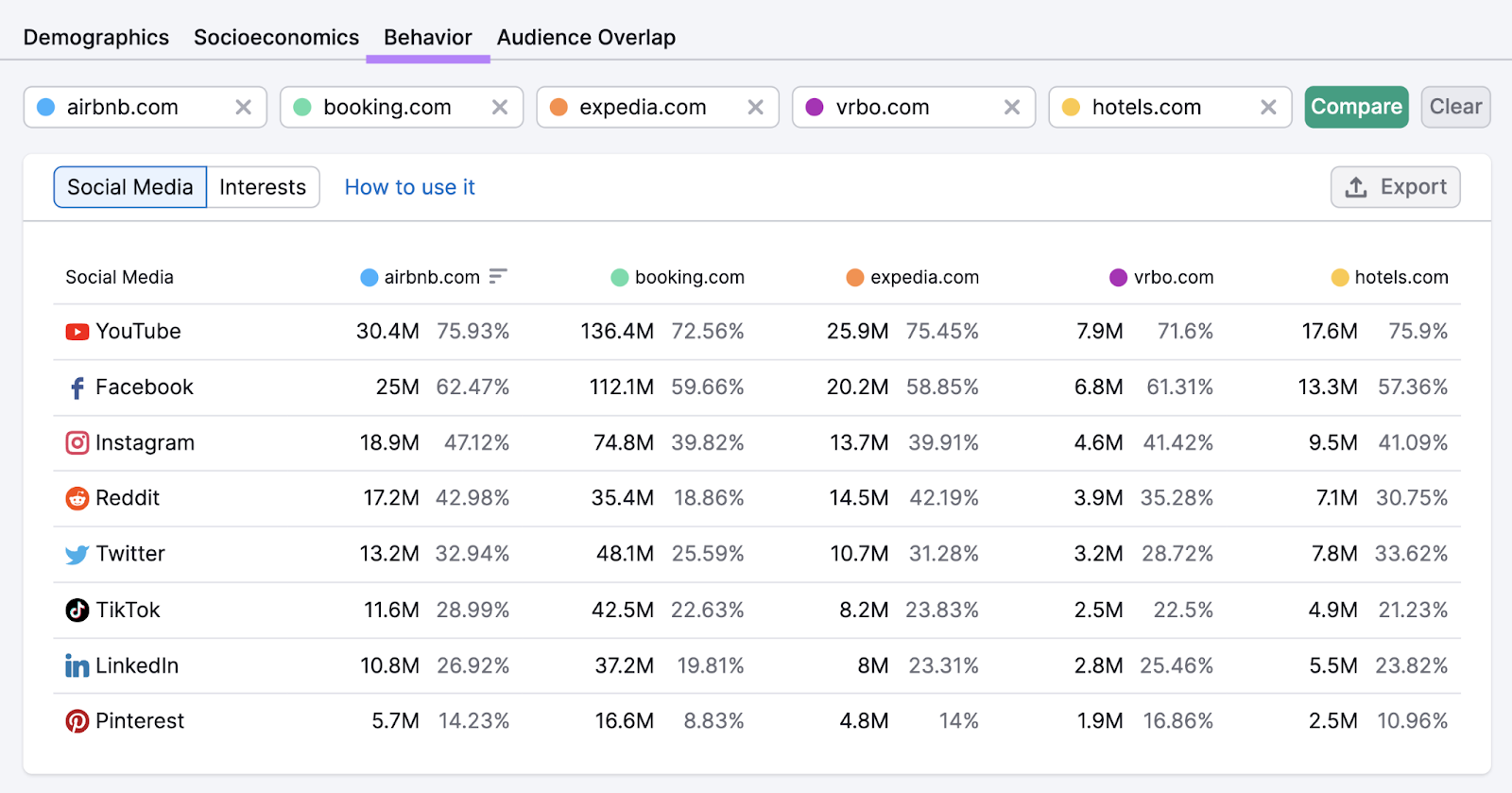
Let’s say you determine that your competitors are primarily targeting people who work full time, are between the ages of 24 and 44, and have a household size of three to four people. That suggests they’re focusing on working parents.
Perhaps this helps you recognize you could stand out by appealing to retired married couples who don’t have children at home.
Further reading: Target Audience: What It Is & How to Find Yours [+ Examples]
4. Changing Customer Preferences
Customer buying habits are always evolving. And marketers have to stay on top of emerging trends to remain relevant.
Consider the growing interest in “clean skincare.” Data from Google Trends shows that this search term grew steadily from 2018 to 2023.
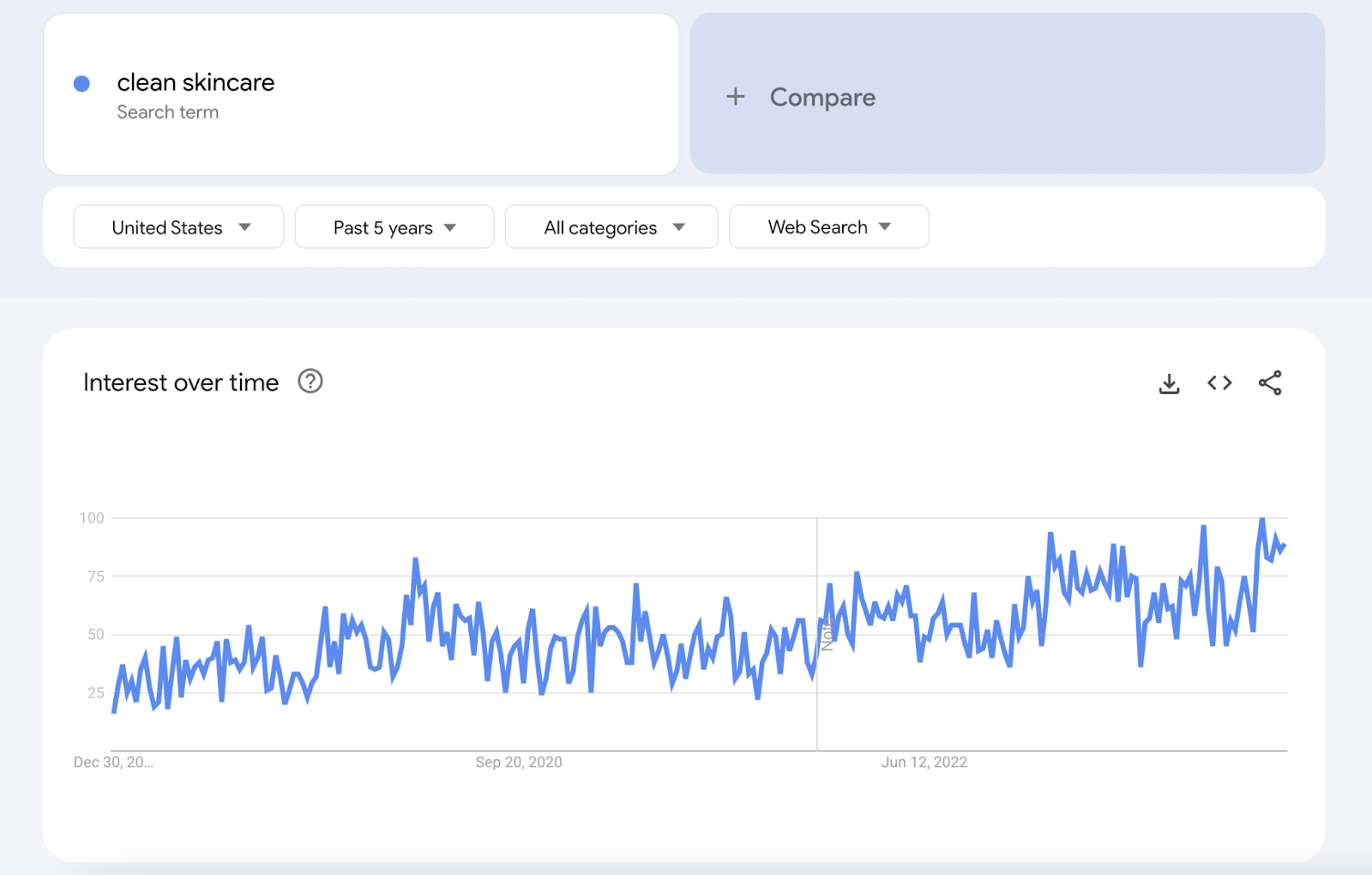
Or the rising popularity of the sport “pickleball” from 2020 to 2023.
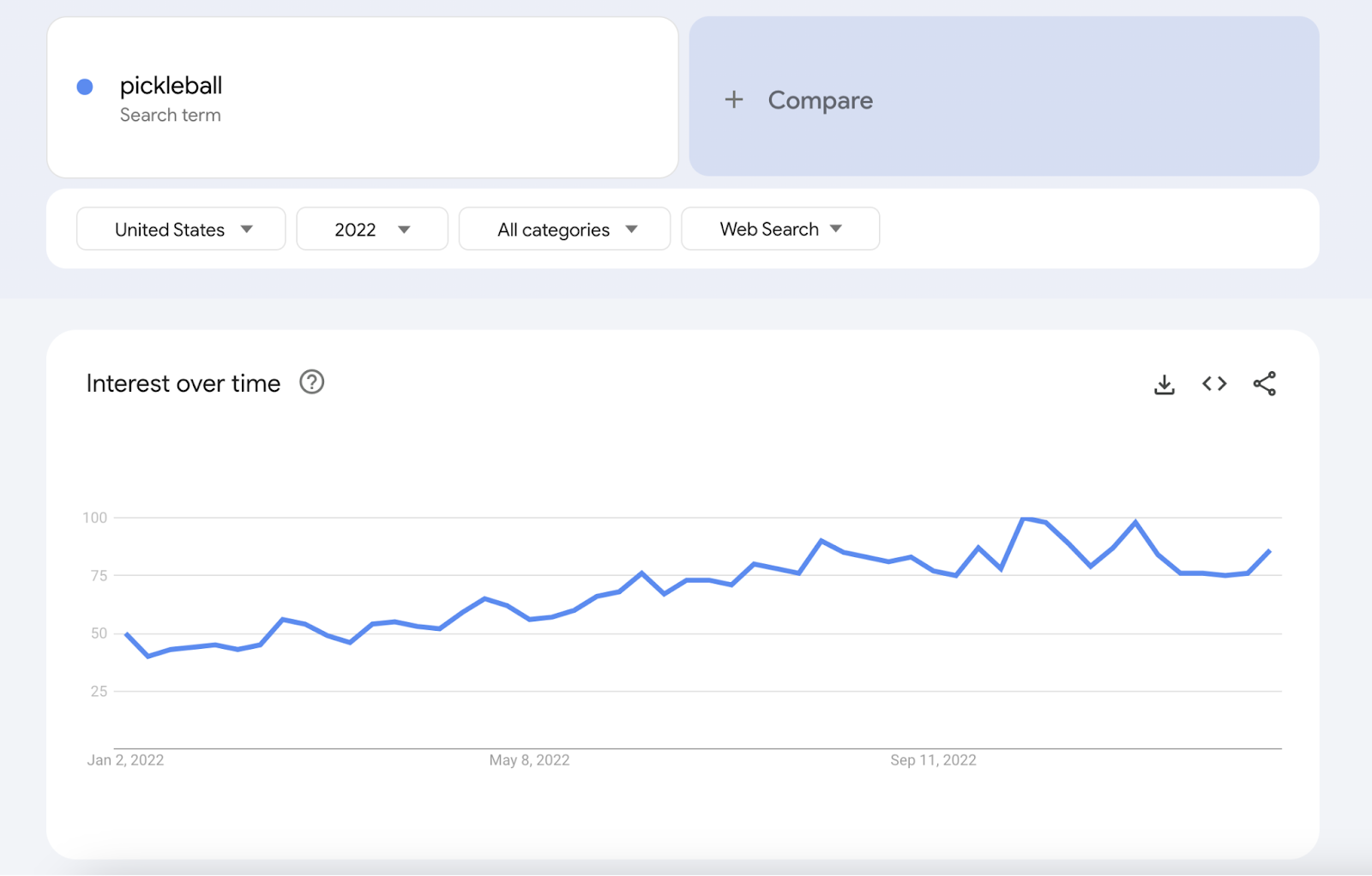
Changes like these mean you can't continue to market how you always have. Doing so will result in decreasing conversion rates and growing customer acquisition costs.
It’s also difficult to identify trends when they’re just beginning to take off. Meaning it’s easy to miss out on opportunities.
How to Solve This Problem
Tracking your competitor’s digital activities in real time can help you uncover new trends you may otherwise be unaware of.
For example, Nike recently created a Pickleball Shoes product category. Which indicates growing popularity for the sport.
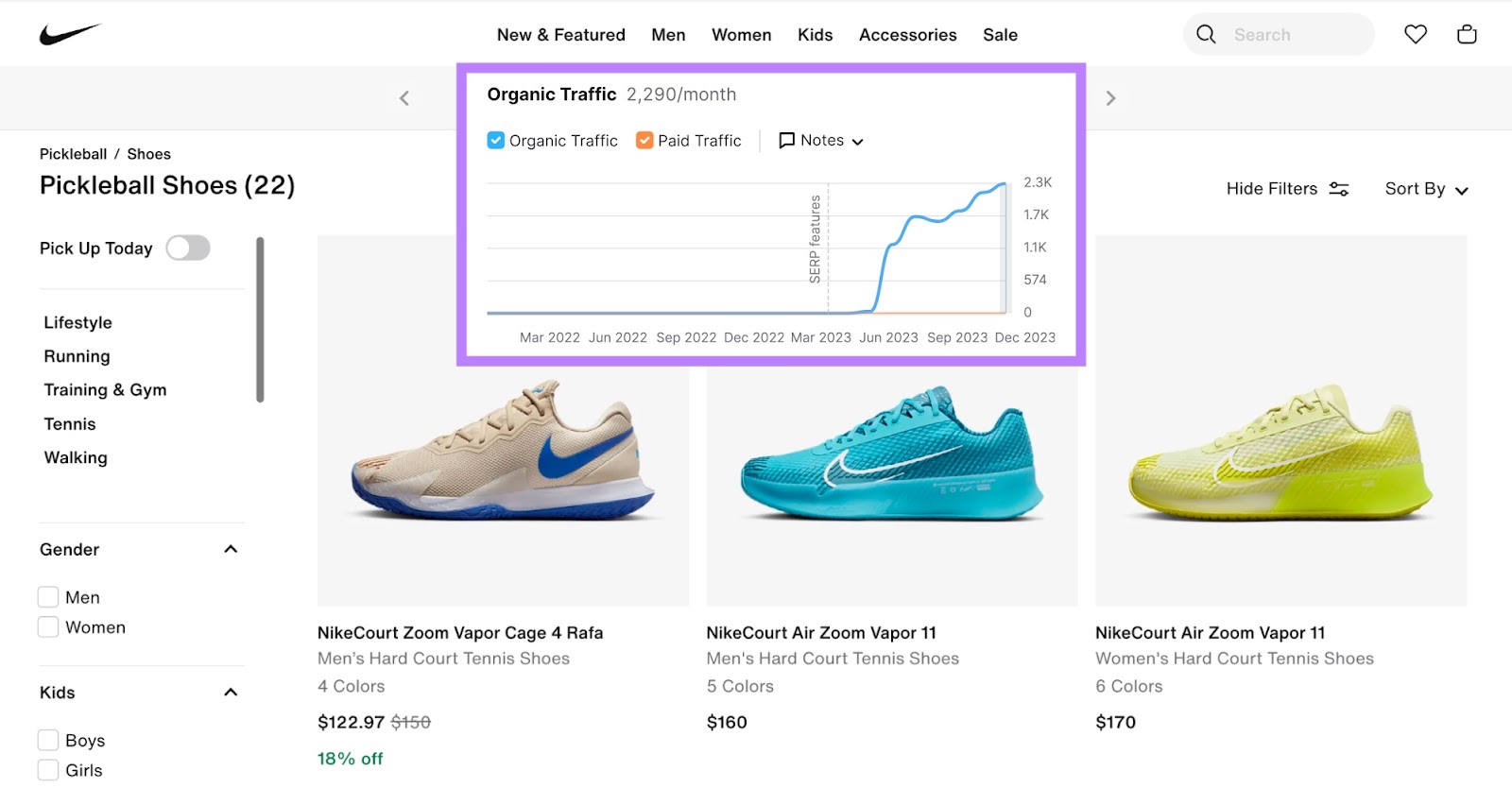
But manually tracking everything your competitors do is time-consuming.
Instead, use a tool like EyeOn to do it automatically.
Simply enter a list of competitors’ URLs and click “Start free monitoring”
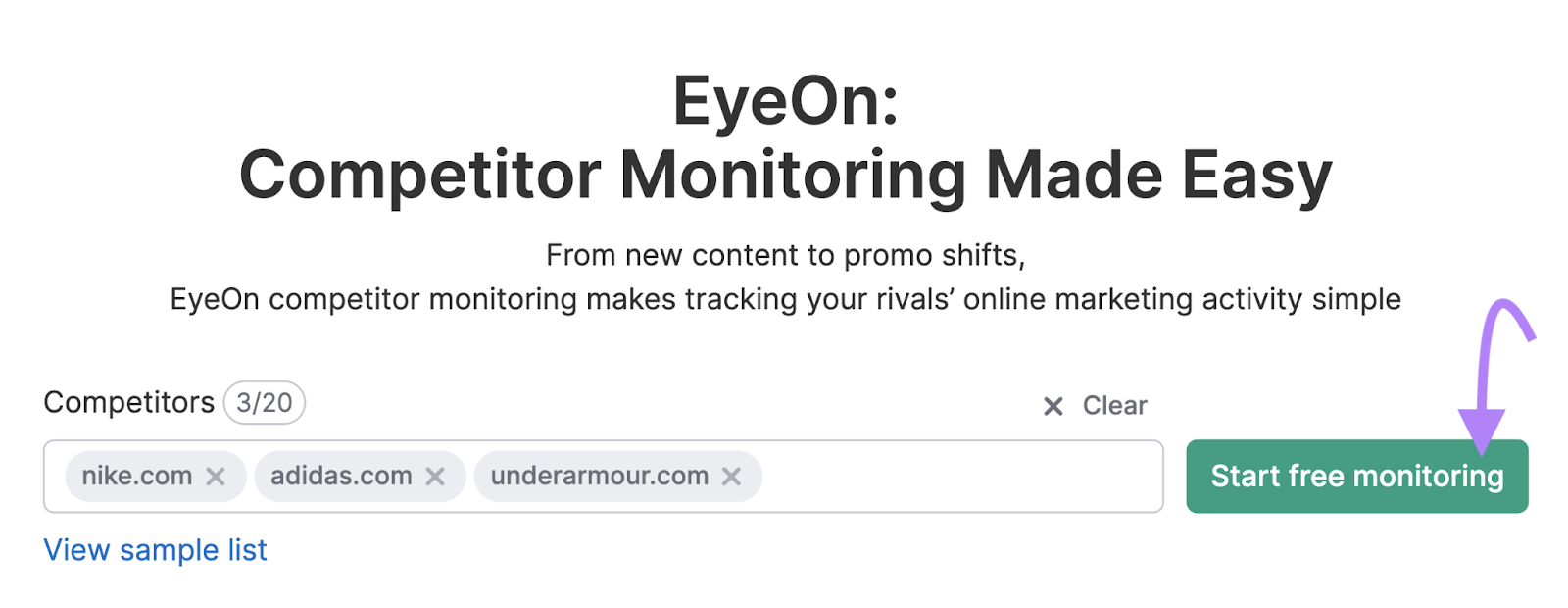
You’ll then be taken to the “Overview” tab. Where you can see aggregated information on your competitors’:
- Google search ads
- Newly published webpages
- Newly published blog posts
- Social media posts
- Social engagement
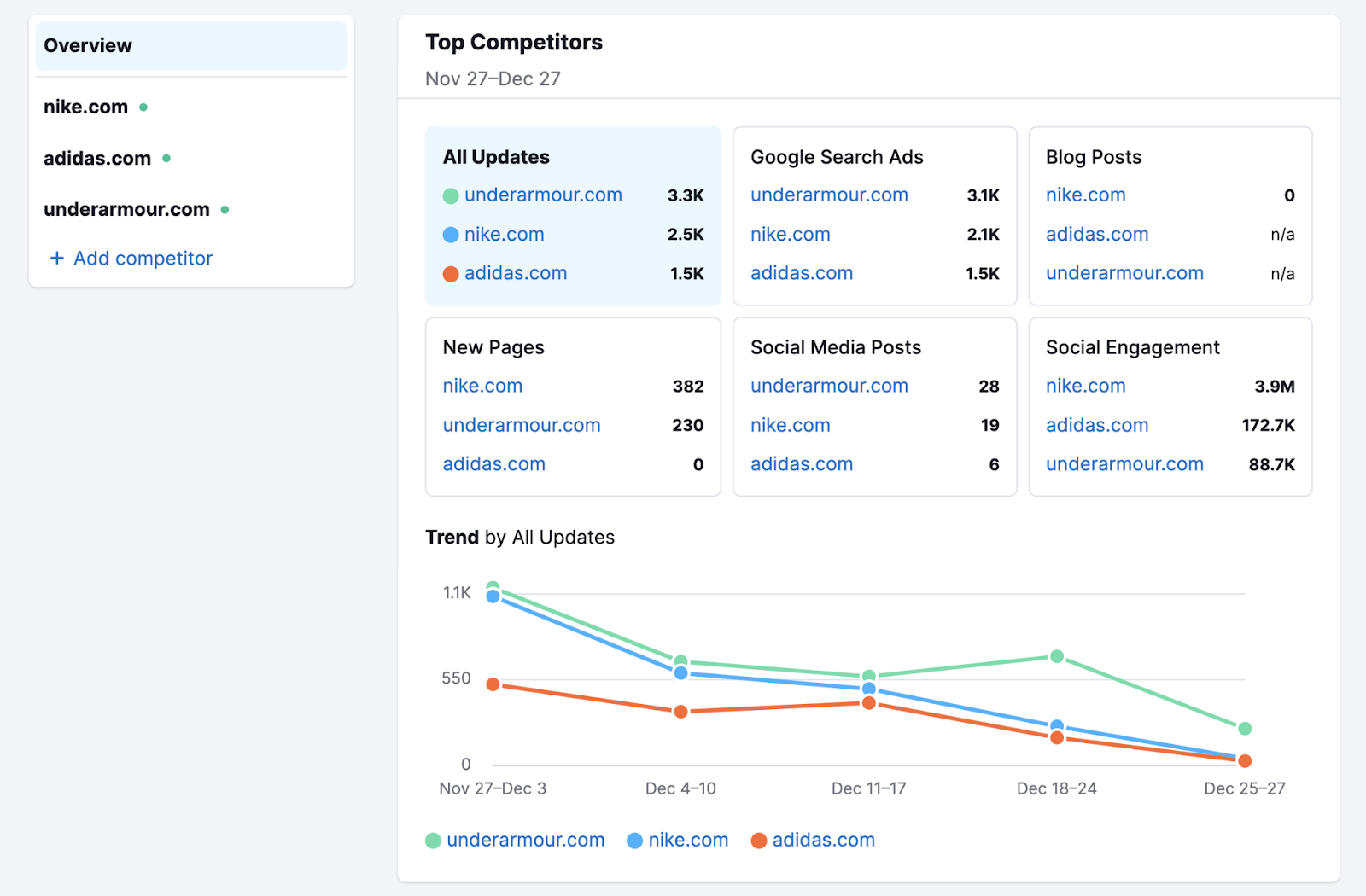
You can then click on a competitor to investigate exactly what new initiatives they’re working on.
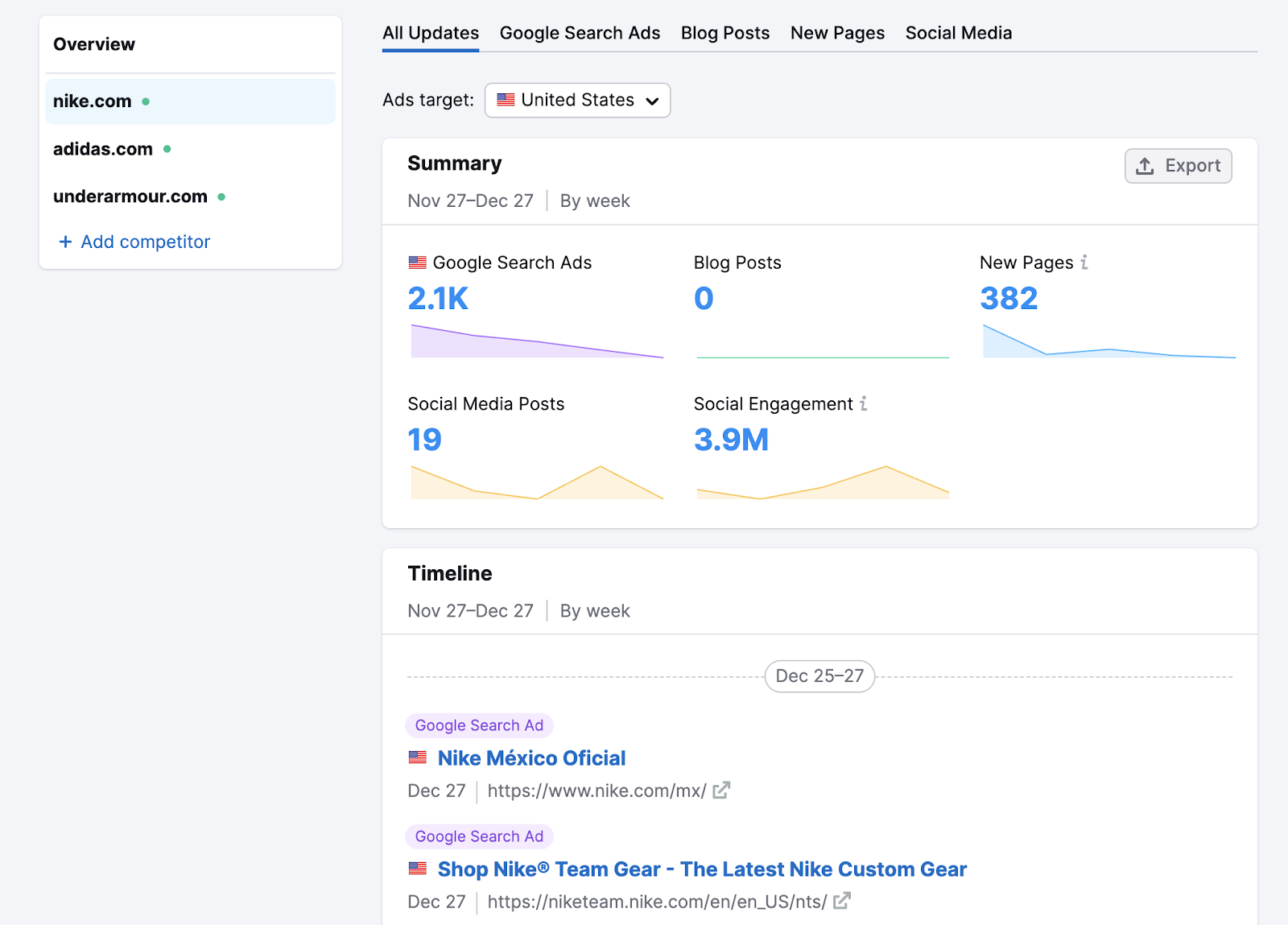
You can even set up weekly emails to get reports delivered directly to your inbox. And even specify which countries you want to focus on for ads.
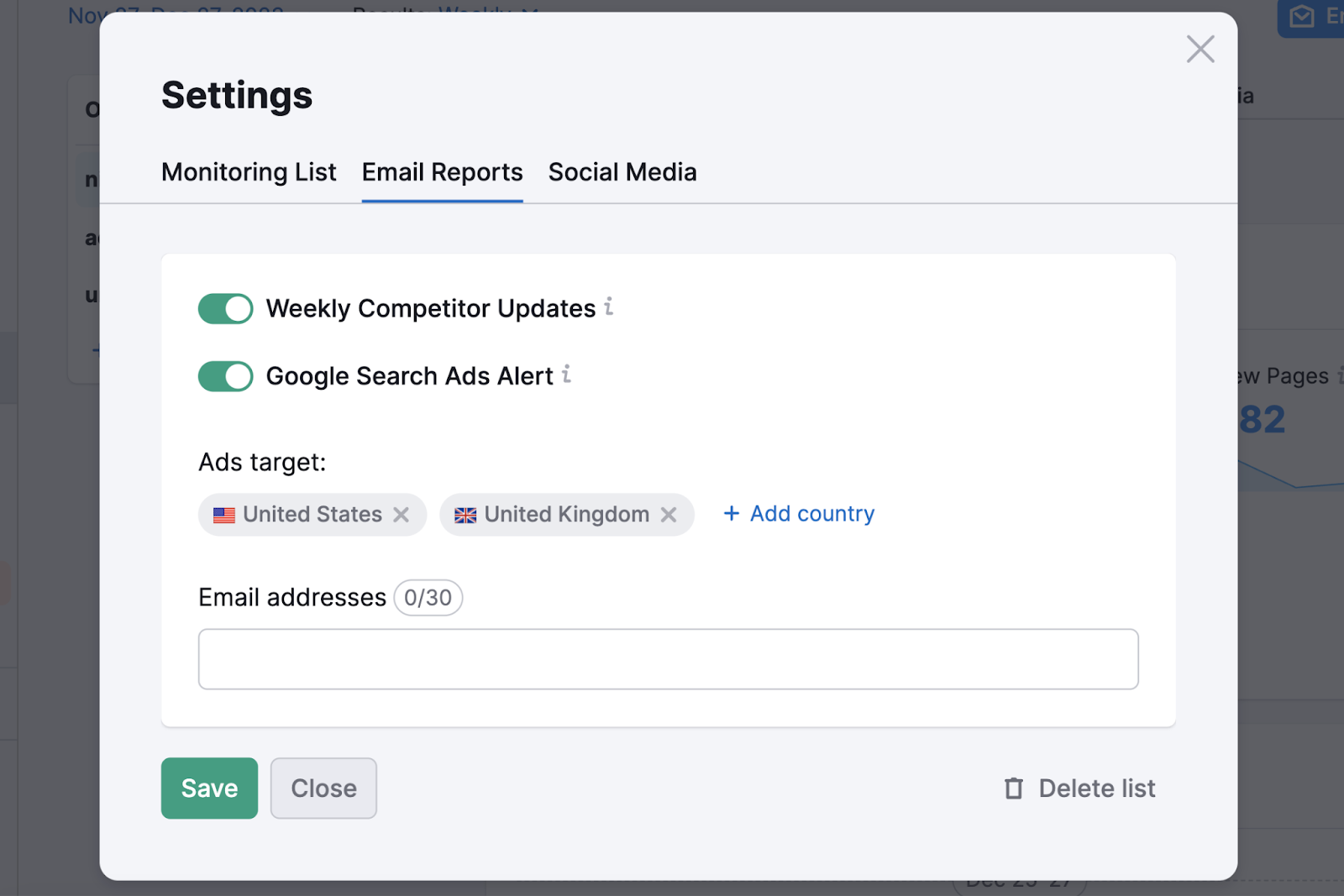
5. Communicating Marketing’s Contributions to Leadership
Communicating marketing’s contribution to business growth is hard. Because it’s difficult to measure in the first place.
A survey of 316 marketing leaders reveals that over 61% of them said showing the impact their actions have on the business’s financial outcomes is a top challenge.
Being able to measure the impact of marketing on your business is important for two reasons.
First, linking marketing success with increased revenue increases the likelihood of leadership allocating a larger marketing budget in the future. Which can be used to grow your team and invest in new channels.
Second, your marketing efforts are more likely to be successful if you know what’s working.
Semrush’s 2023 State of Content Marketing report reveals 70% of businesses that were very successful in content marketing actively measured marketing return on investment (ROI).
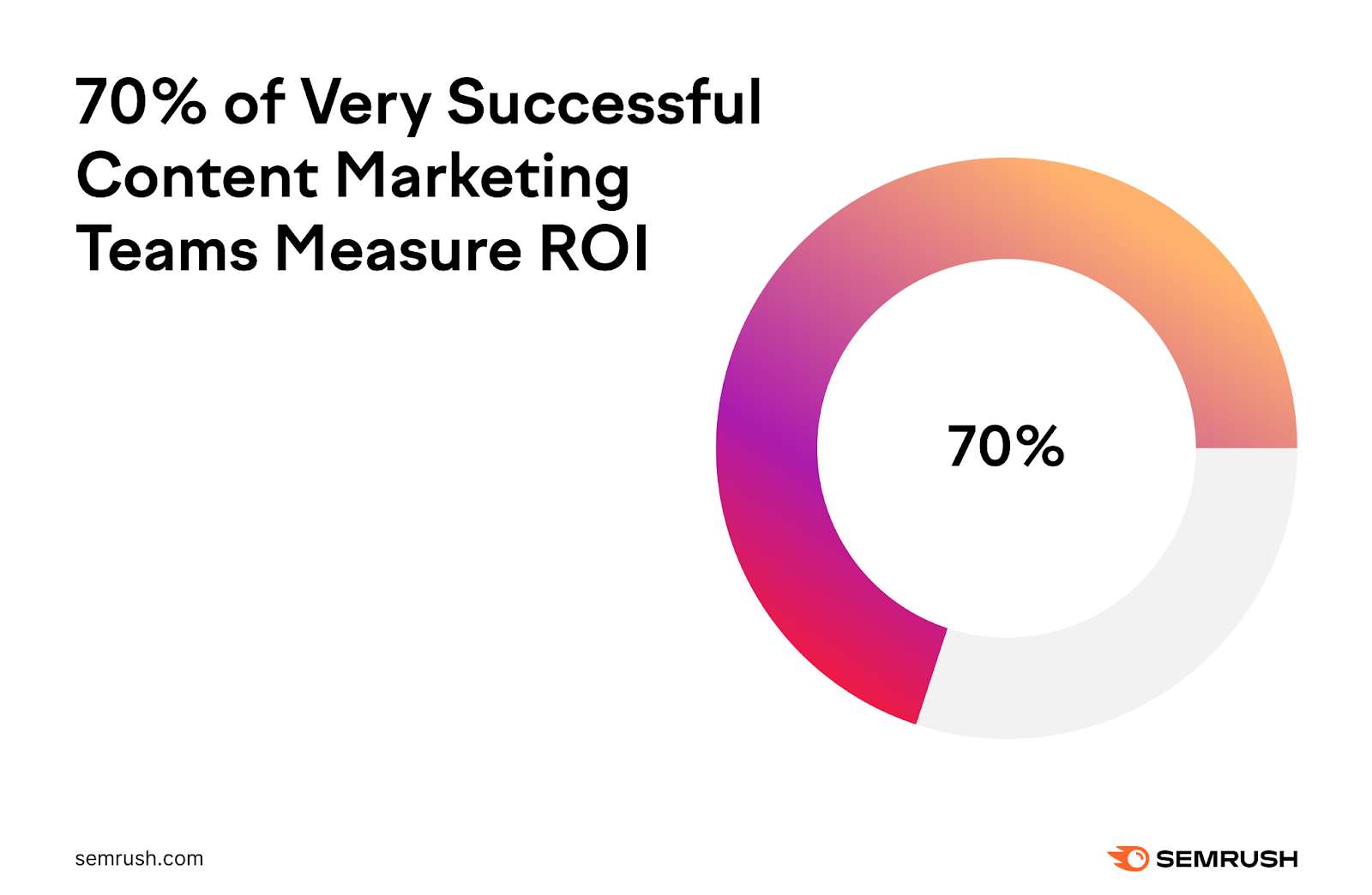
How to Solve This Problem
Try measuring how effective each individual marketing discipline is. Then, you can create a master report for leadership.
Let’s walk through how to do this for SEO.
First, you’ll need to set up conversion events for lead-generating activities in Google Analytics. That could be downloading a template or filling out a form.
Navigate to “Admin” in the sidebar to the left and select the “Events” section.
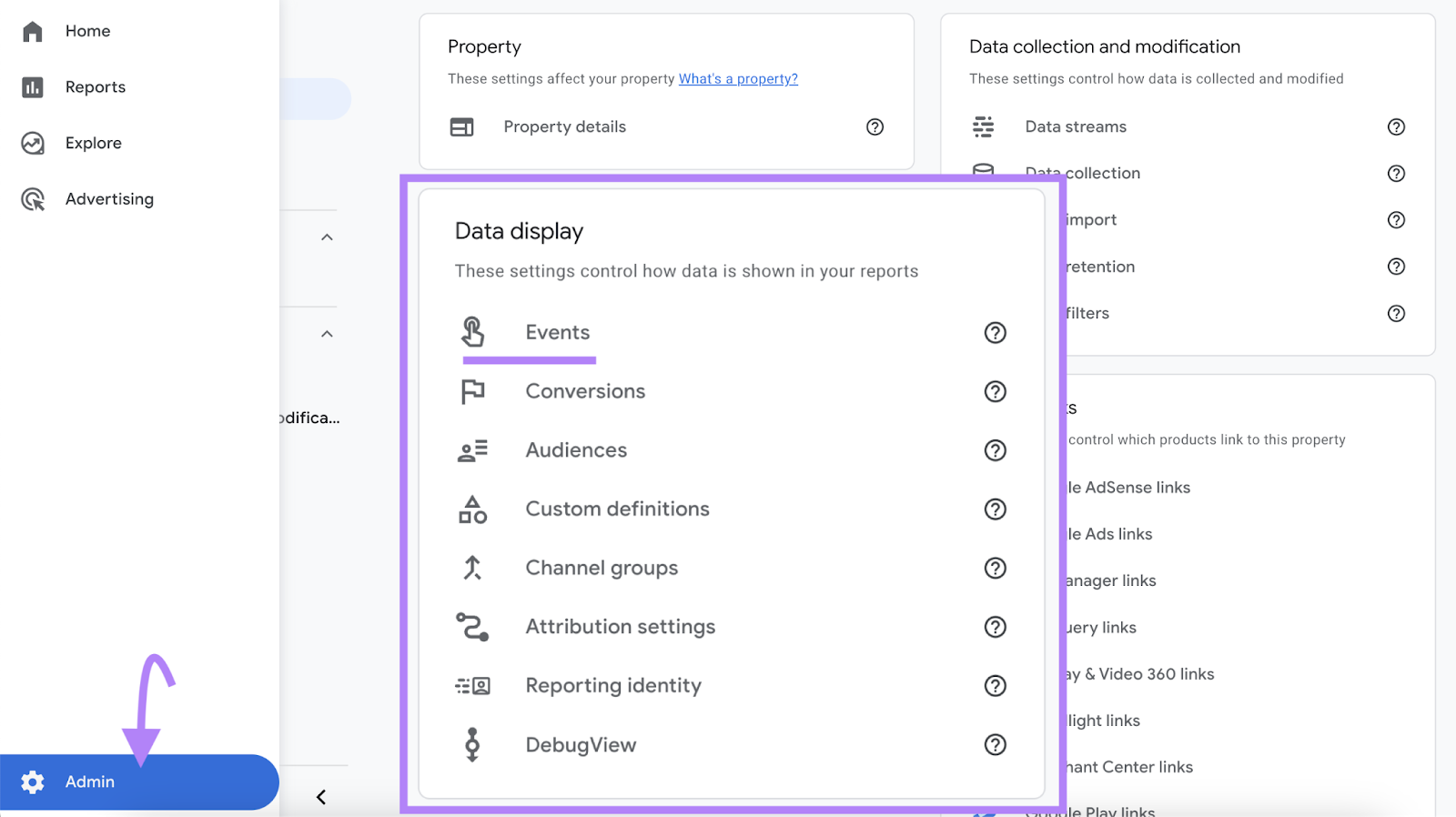
Then, select “Create event” to create an event that aligns with the activity you want to track.
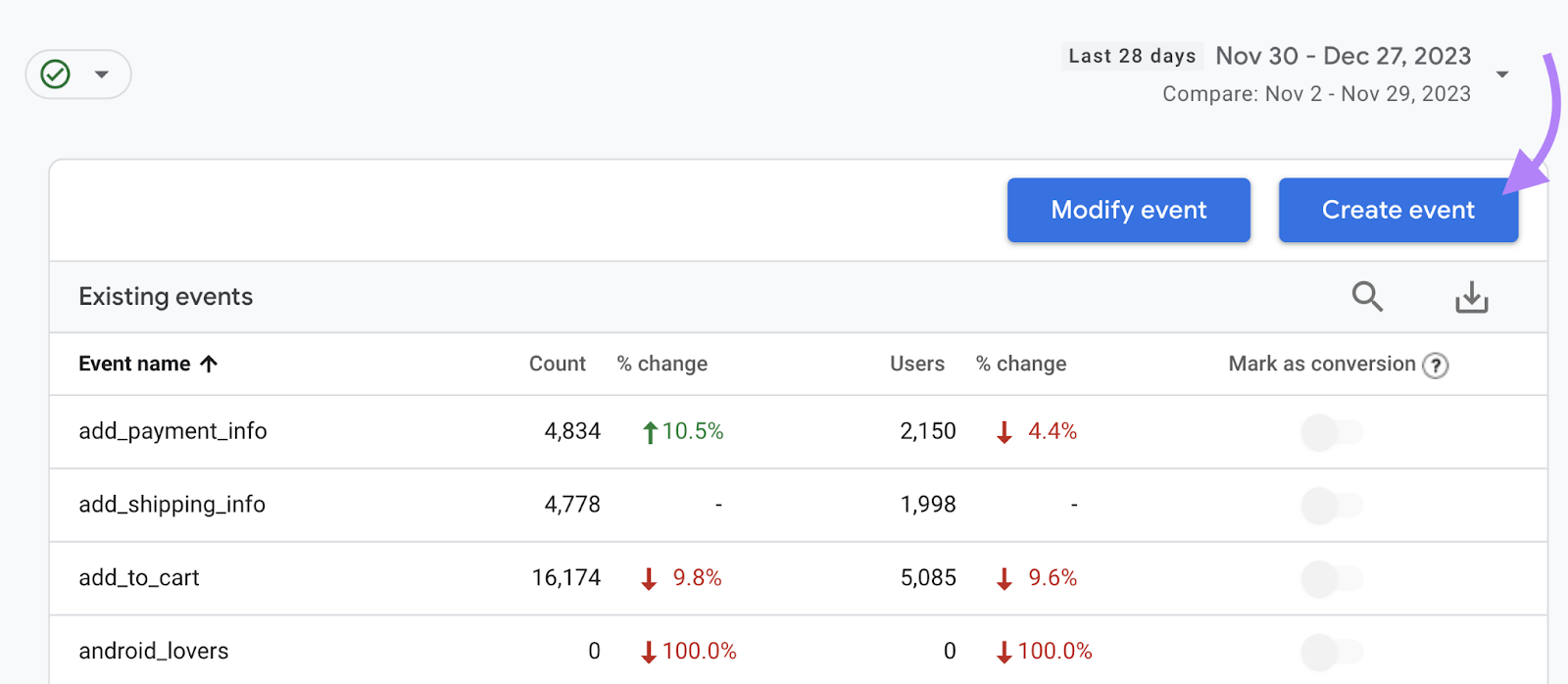
You’ll need to do this for each conversion you want to measure.
But here’s how you can create an event for a form submission.
First, choose a name for the event. And then set the “Parameter,” “Operator,” and “Value” fields to indicate a form submission.
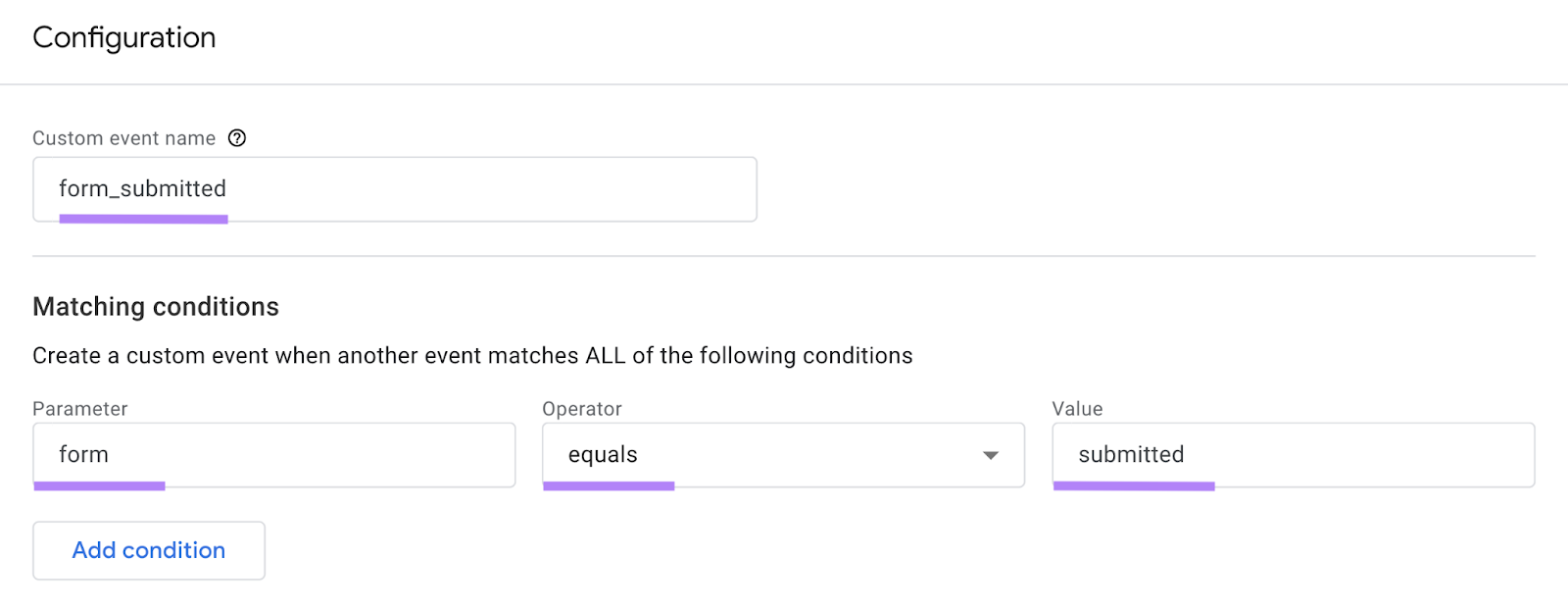
The event should now appear in your “Existing events” table. Find it and select the toggle under “Mark as conversion.”
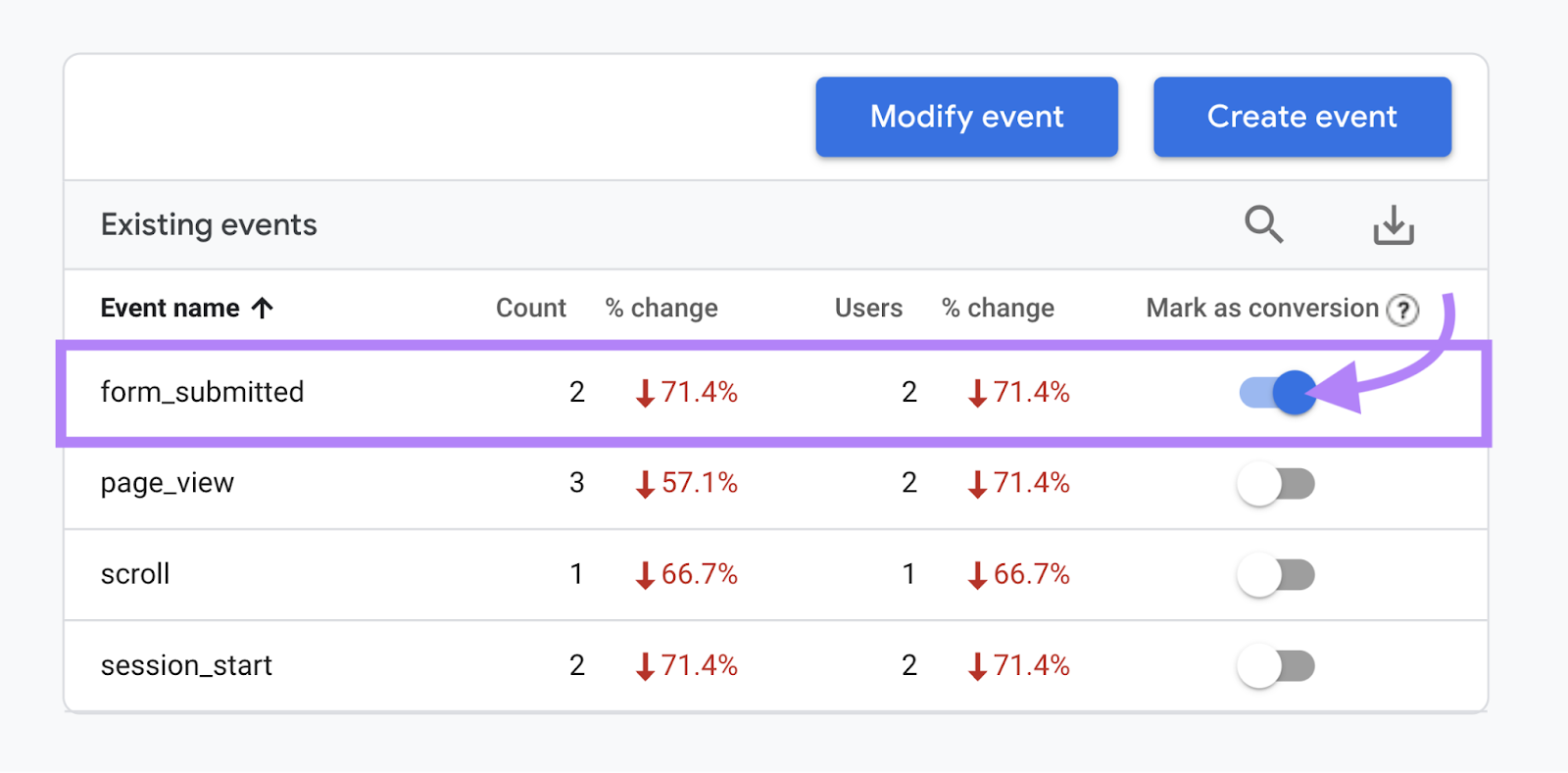
After about 24 hours, Google Analytics populates this information in the “Conversions” report.
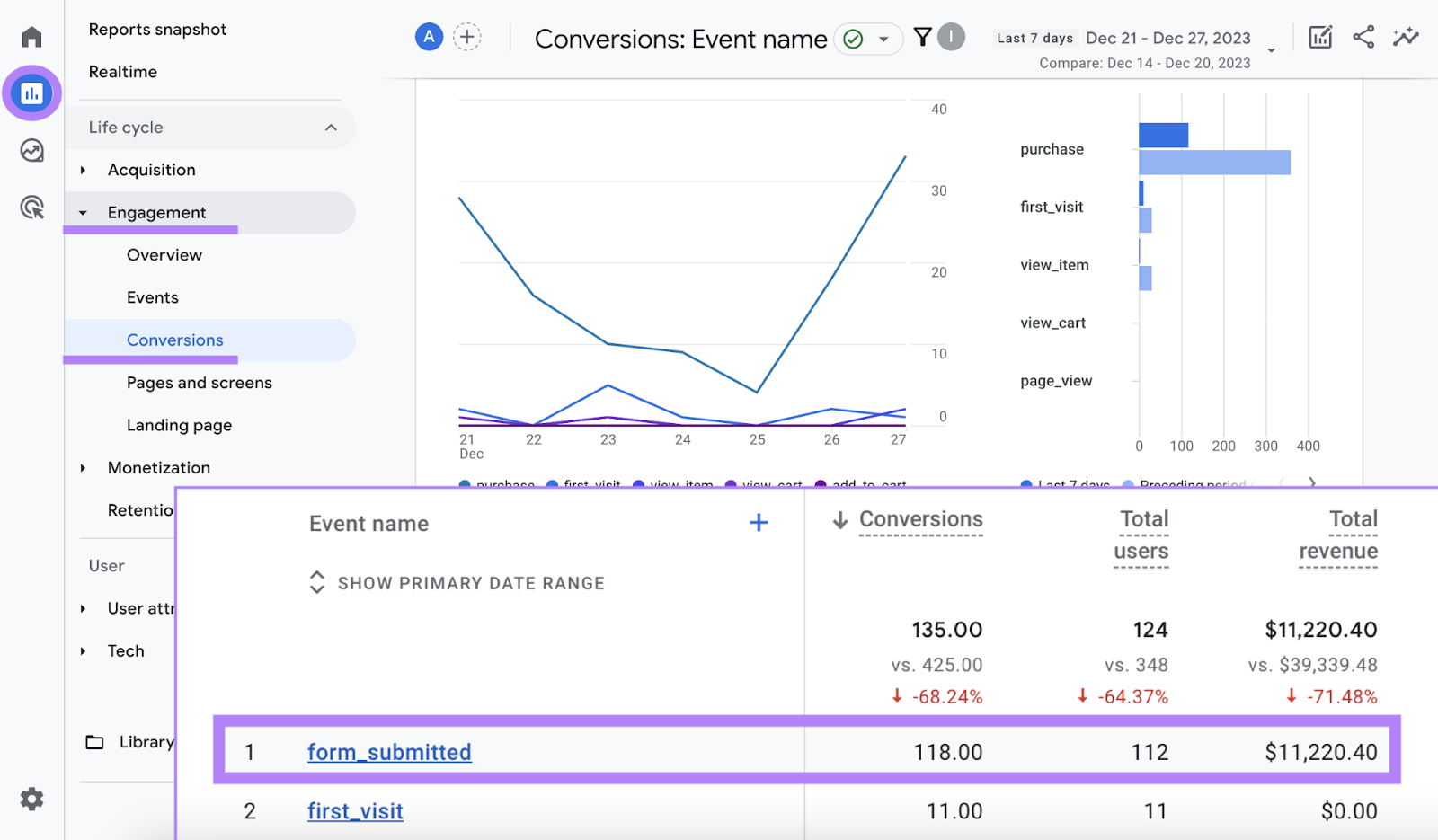
You can then filter this report to only show you conversions that originated from your SEO efforts by clicking “Add comparison” at the top of the report.
Then, select “Session medium” in the “Dimension” drop-down menu, “exactly matches,” in the “Match Type” drop-down menu, and “organic” in the “Value” drop-down menu. And click “Apply.”
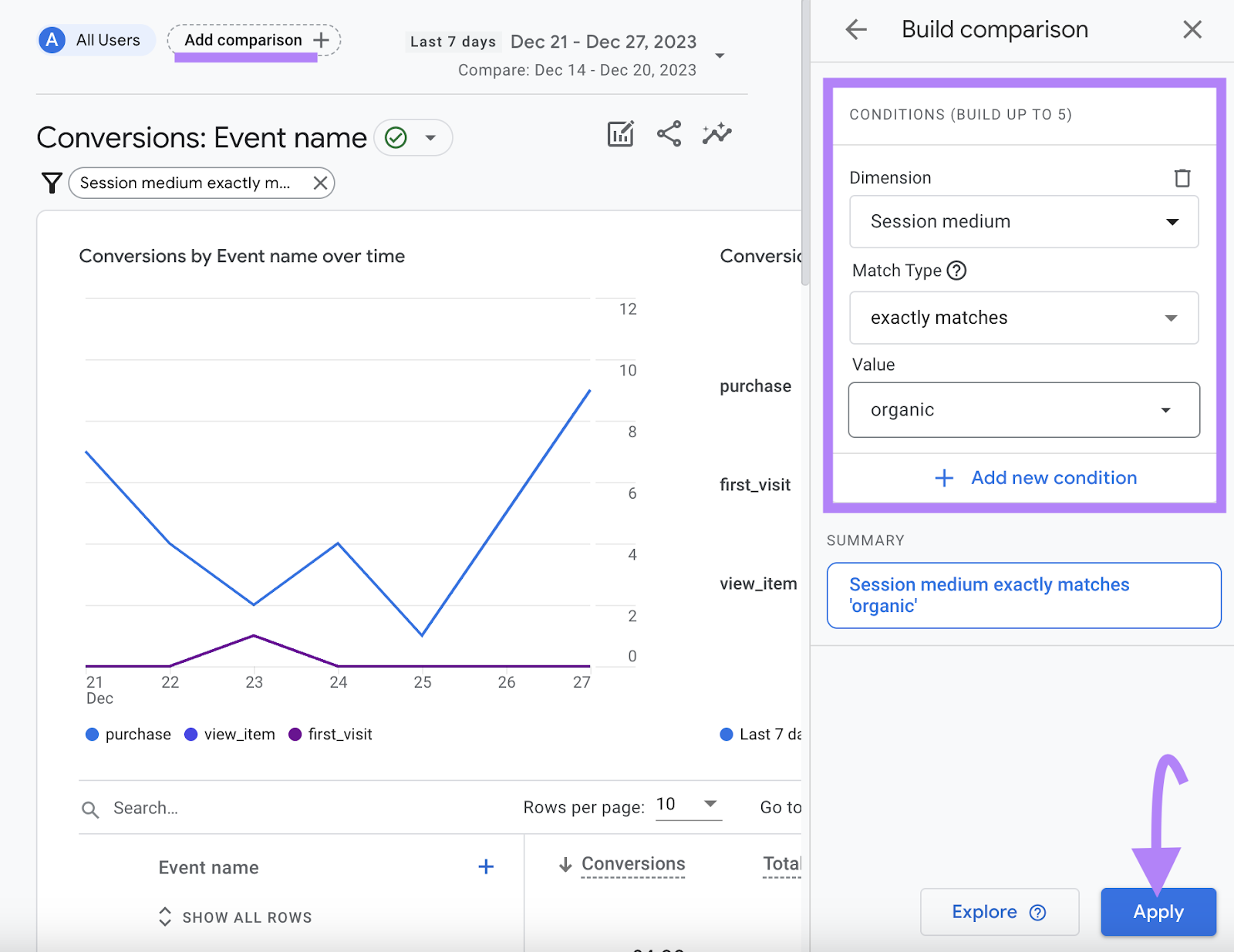
Now, you’re able to see how SEO marketing activities generate conversions.
If you assign a numerical value to each conversion (which you can determine by multiplying your typical customer lifetime value by your lead conversion rate), you can then determine the overall value of all your conversions. And use that to calculate your SEO ROI.
Here’s the formula to do that:
SEO ROI = (total conversion value - cost of investment) / cost of investment
You can then do this for other marketing disciplines, populate the data in a report, and share with your leadership team.
6. Training Marketing Team Members
Training is time-consuming and can divert resources from marketing activities that more immediately generate revenue.
This isn’t just for getting new hires up to speed. Helping your existing team members sharpen their skills also takes time and resources.
But good training is essential for ensuring everyone on your team is able to perform their jobs to the best of their abilities. It also helps reduce attrition, according to a report from LinkedIn.
How to Solve This Problem
Setting aside dedicated training time in your team’s calendar ensures training is always prioritized. And lets you plan for it in a way that won’t get in the way of achieving your goals.
If you’re short on senior team members who can teach others, assign self-taught courses for your team to complete. Like those in Semrush Academy.
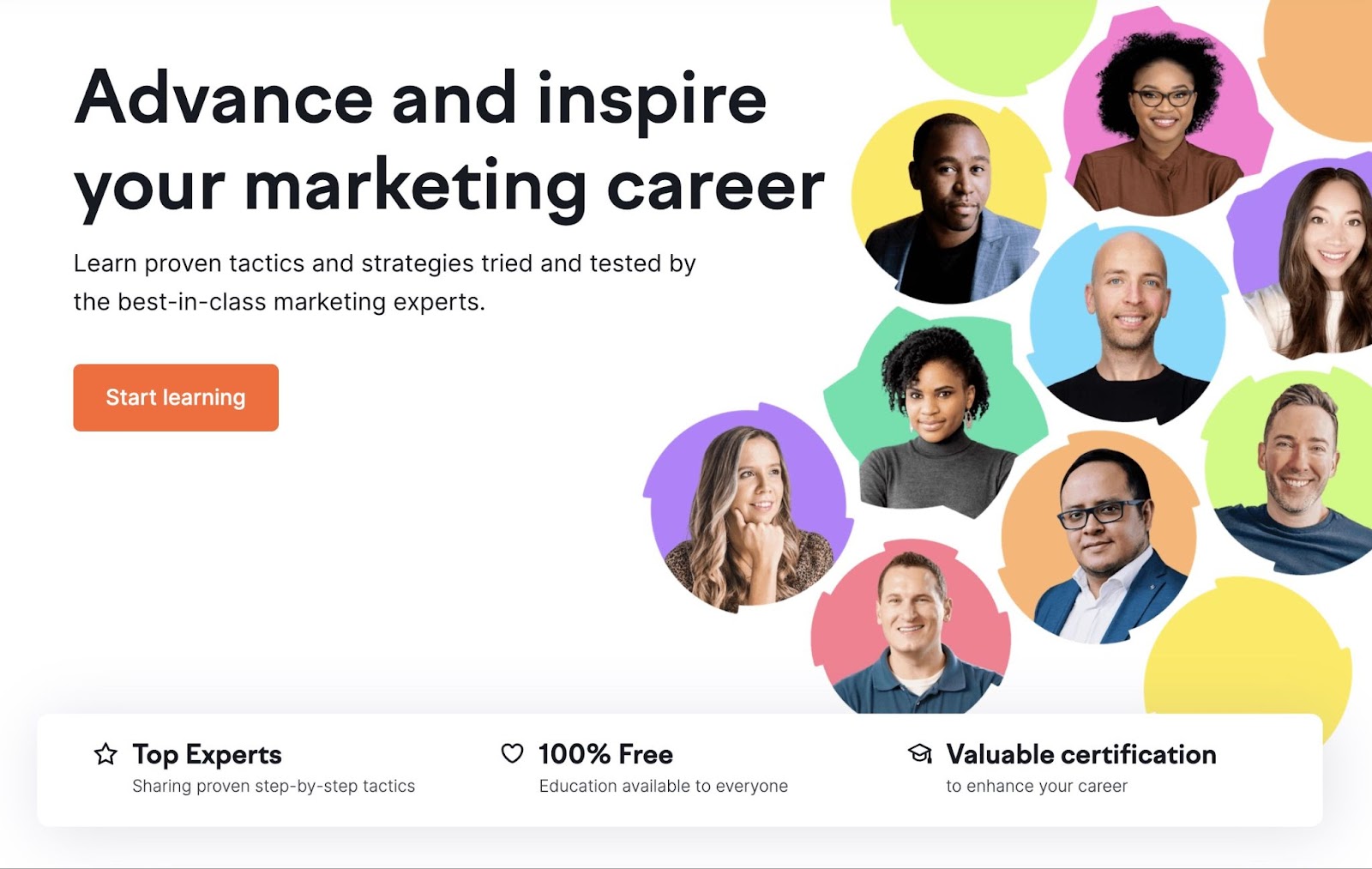
7. Marketing with a Reduced Budget
Many marketing teams have had their budgets cut in recent years. Meaning they’re trying to deliver comparable results without as many resources.
In fact, a Gartner survey reveals marketing budgets fell from 9.5% of revenue in 2022 to 9.1% in 2023. And 71% of CMOs now believe they lack sufficient budgets to execute their strategies.
In short, marketing teams are being forced to make hard decisions. Often putting off plans for experiments and even cutting back on freelance contributions.
How to Solve This Problem
Focusing on your best-performing marketing activities and simultaneously cutting budget for inefficient channels can help you maximize revenue while minimizing your overall spending.
Let’s say you identify that your SEO efforts drive far more sales than your organic social media efforts.
Even if you don’t have enough budget to create as much net-new content as you’d like, you can get more out of your SEO work by optimizing your existing content.
A Backlinko study shows that improving a page’s keyword ranking from position 4 to position 1 can increase clicks through to your page by more than three times.
First, identify which pages are worth investing resources into improving.
You can do this using Position Tracking.
Follow the Position Tracking configuration guide to set up the tool.
Then, head to the “Pages” tab. And click the column with the date underneath “Average position” twice to sort the results from highest-ranking pages to lowest-ranking pages.
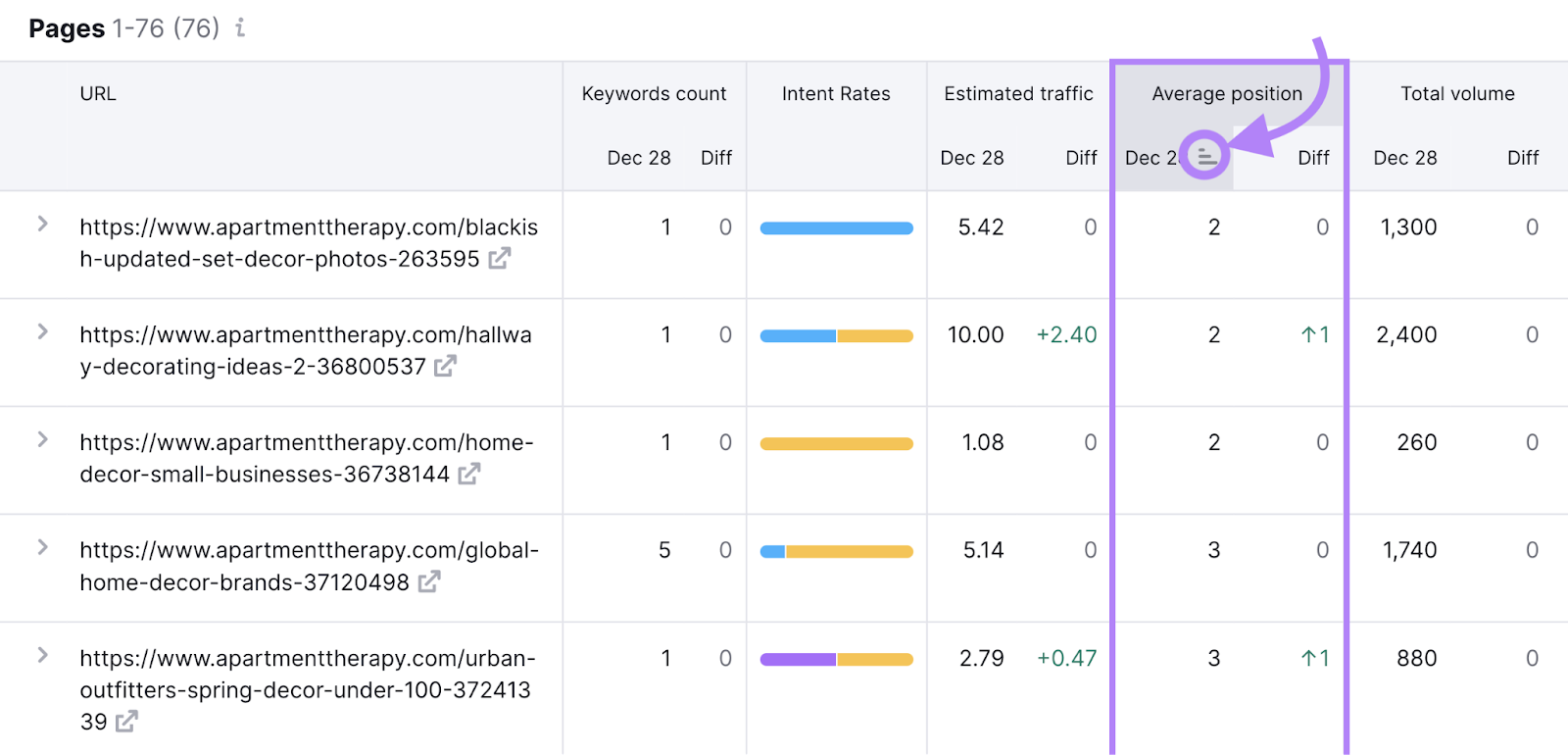
Now, scroll down to find pages where the average ranking is between position 4 and position 10.
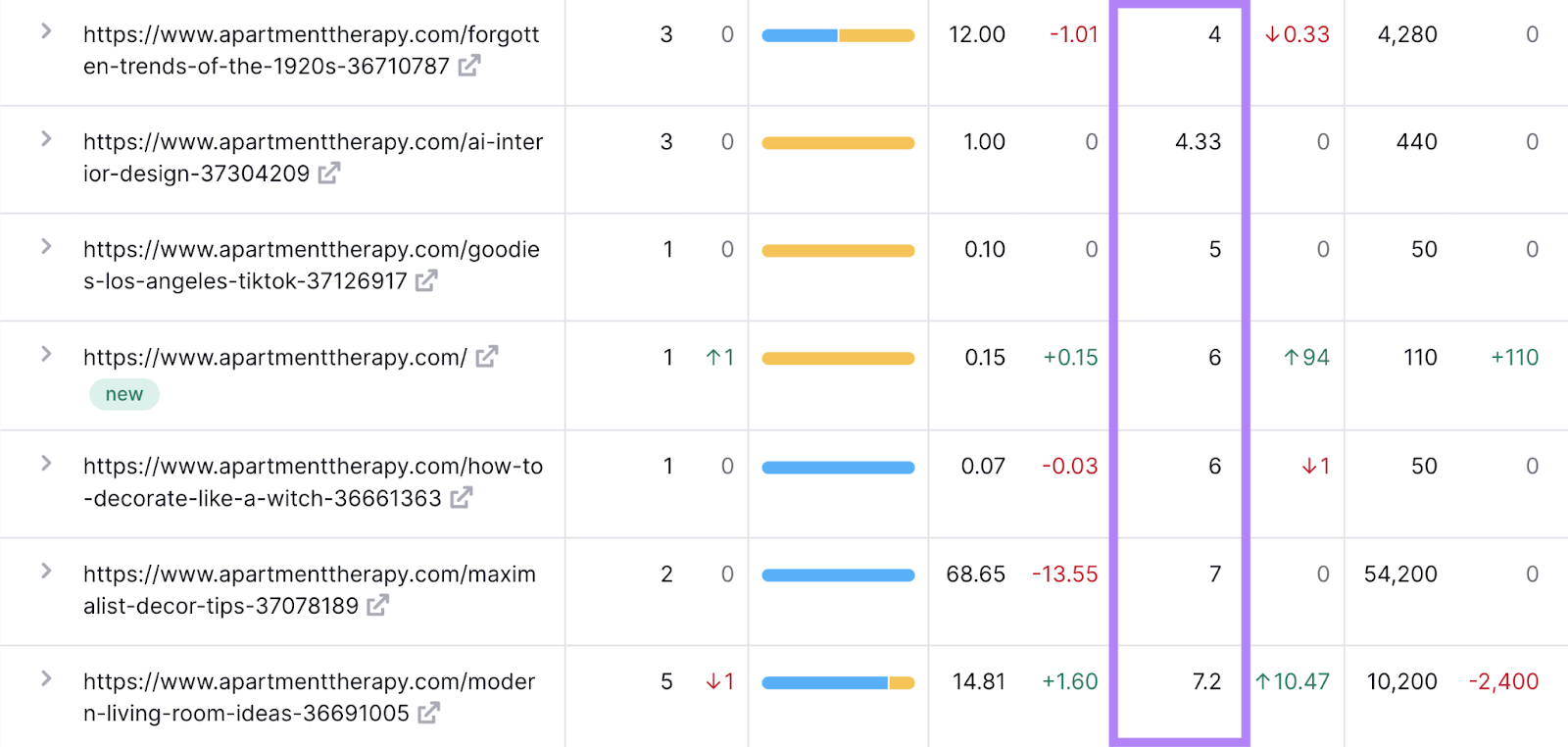
These are pages you can easily optimize to drive better results.
For specific recommendations on how to improve these and other important pages, go to Semrush’s On Page SEO Checker.
Follow the On Page SEO Checker configuration guide to set up your project. And make sure to select the “Manually” tab when adding pages to make sure all the ones you identified from Position Tracking get included.
Then, click “Collect ideas.”
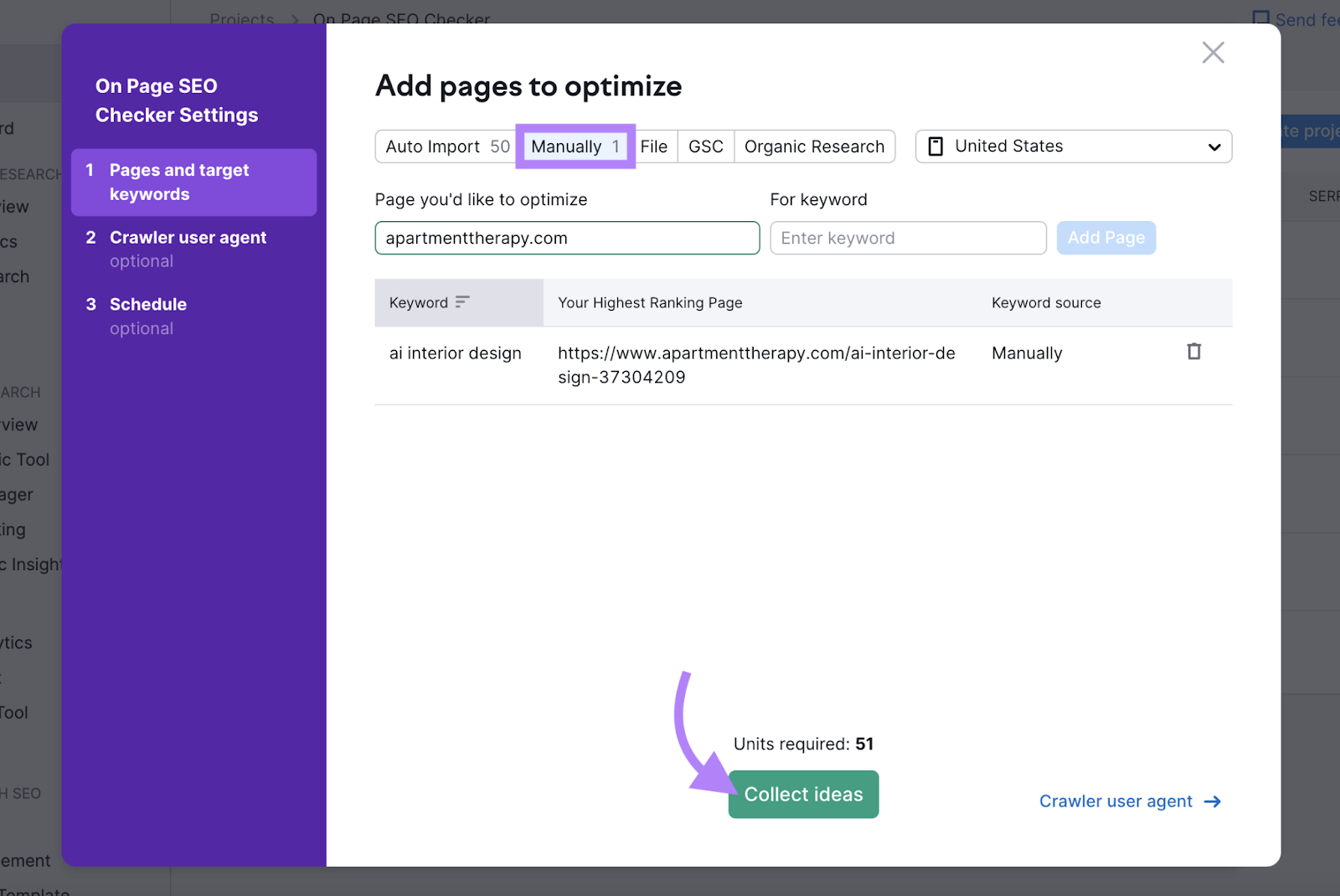
The “Overview” tab will show you a high-level look at some ideas to improve your pages. And how much traffic you could gain by implementing them.
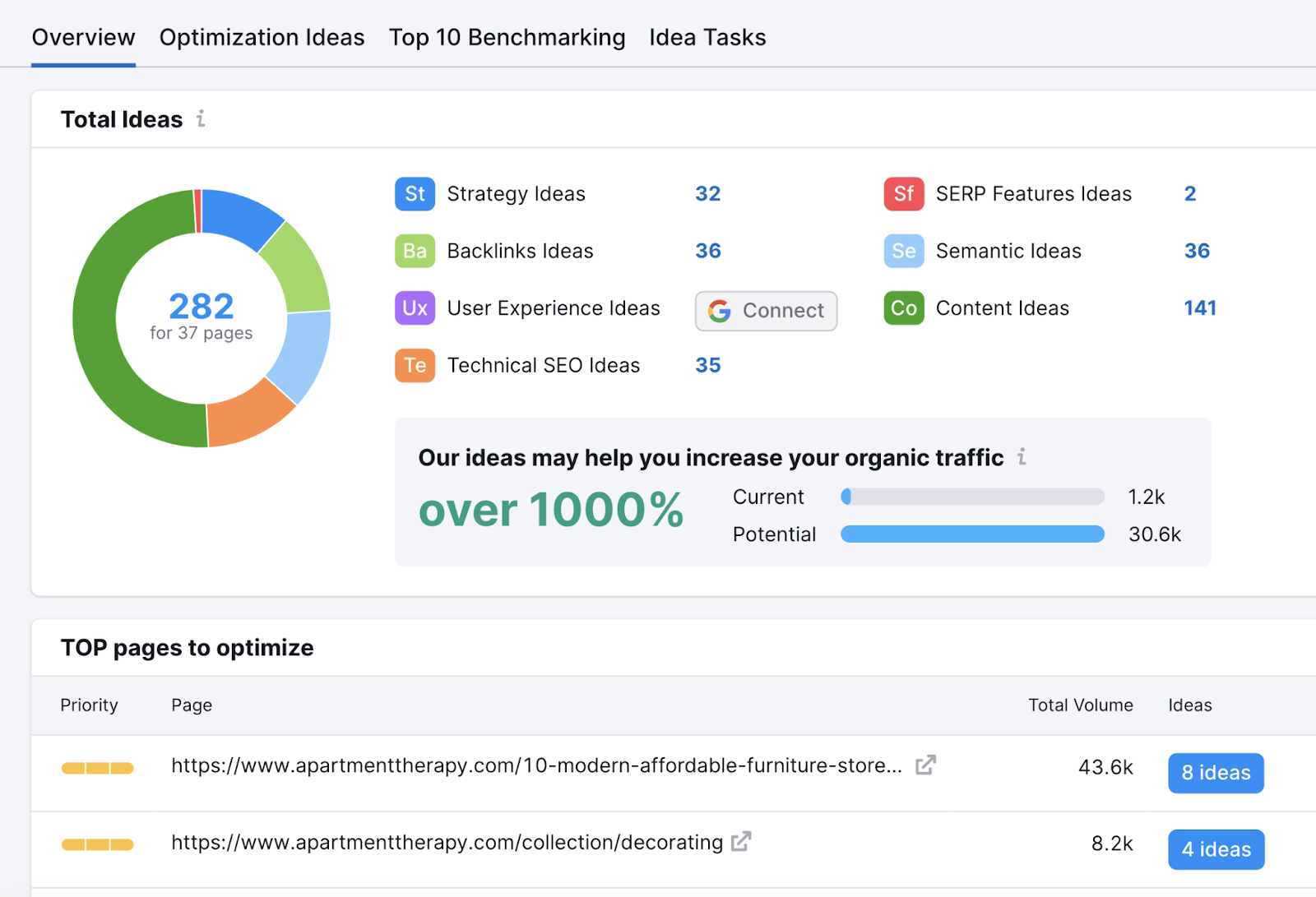
Click the “Optimization Ideas” tab to see specific recommendations for individual pages.
All recommendations are highlighted with clear instructions.
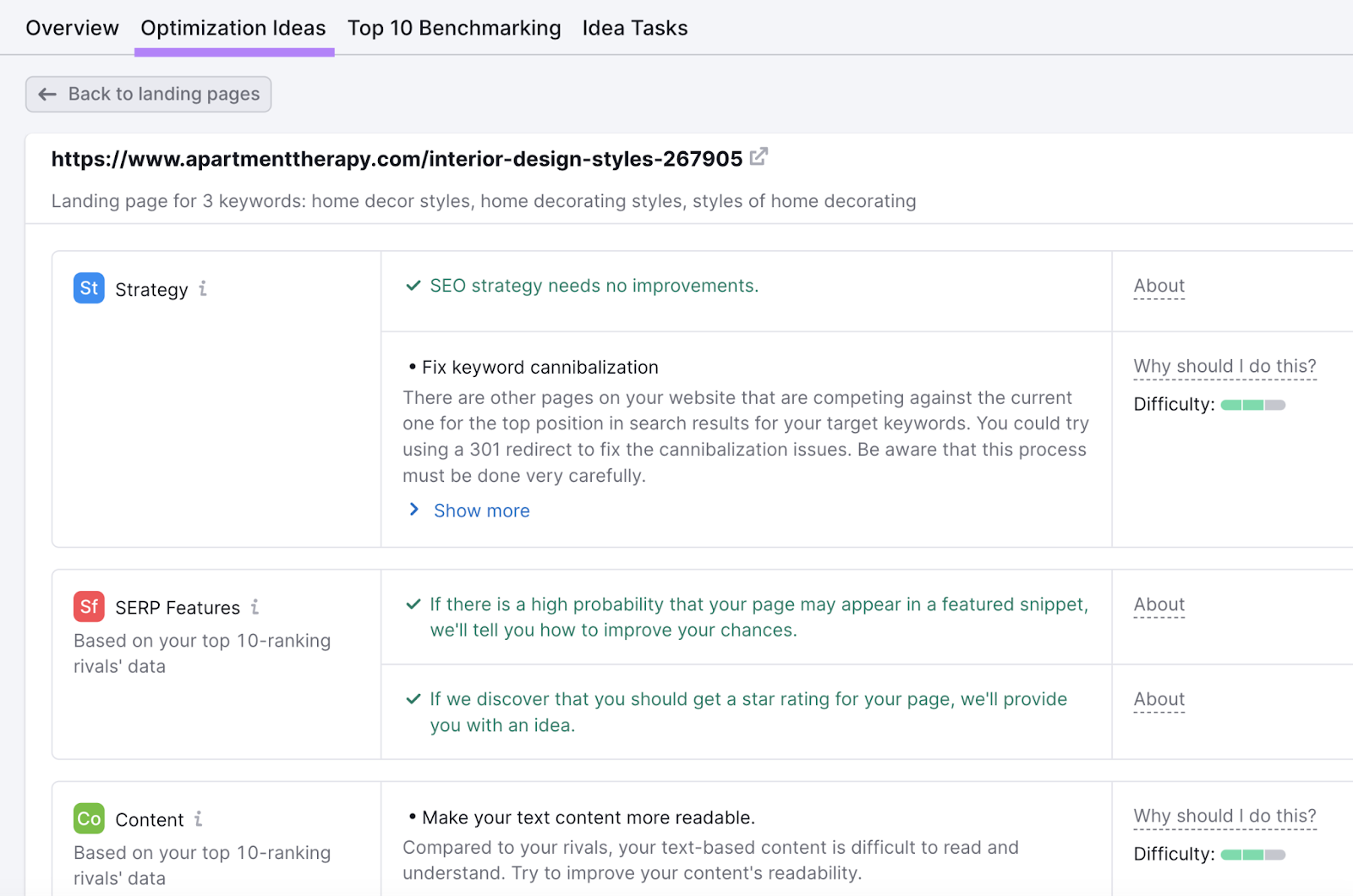
You can follow these recommended steps to improve SEO rankings for key pages. To get more value out of them.
8. Recruiting Top Talent
Hiring top-tier marketers is difficult. Because potential hires have new working preferences and options that align with those.
For example McKinsey & Company found that 87% of employees would choose to work remotely if given the option.
If a candidate has the choice between a remote role at another company and an in-office role at your company, it’s likely they’ll opt for the former.
It’s important to recognize employee preferences like this. And find ways to accommodate them or provide other incentives.
How to Solve This Problem
Maybe you’re able to offer flexible work environments. If so, that can help in your recruitment efforts.
But what about when you can’t meet every employee preference?
You can encourage your existing employees to post about open roles on LinkedIn. Or even reward them with a referral bonus if their promotion leads to a hire.
Here’s an example that Zoë Hartsfield posted on LinkedIn. The post praises the Apollo.io team and promotes various open roles.
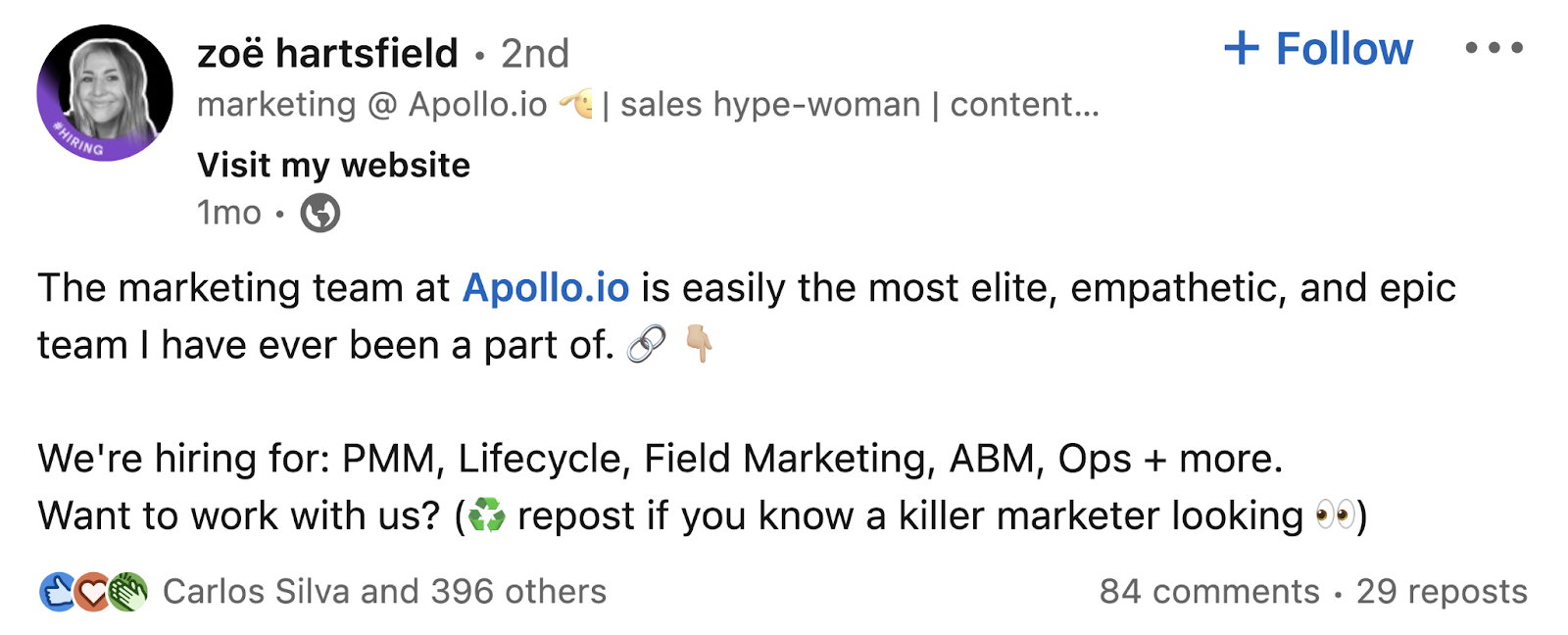
For a potential candidate, Apollo.io looks like a great place to work. And for Apollo.io, this is an authentic and low-cost way to advertise open job roles.
9. Testing New Marketing Channels Efficiently
Trying new marketing channels is a good way to discover opportunities and stay ahead of the competition. But it takes a lot of experimentation to discover what works.
This can be problematic when you consider how risky the prospect of wasting resources on something that might not work sounds to leadership.
CallRail’s survey of more than 600 marketers at small- to medium-sized businesses shows 67% find it’s hard to get buy-in from leadership on potential new channels.
How to Solve This Problem
Analyzing what’s working for competitors on new marketing channels and presenting those findings to leadership is more likely to help you get buy-in. And to help you succeed.
First, you’ll need to identify marketing channels your competitors are using that you aren’t.
Enter their domains into Semrush’s Traffic Analytics tool and click “Analyze.”
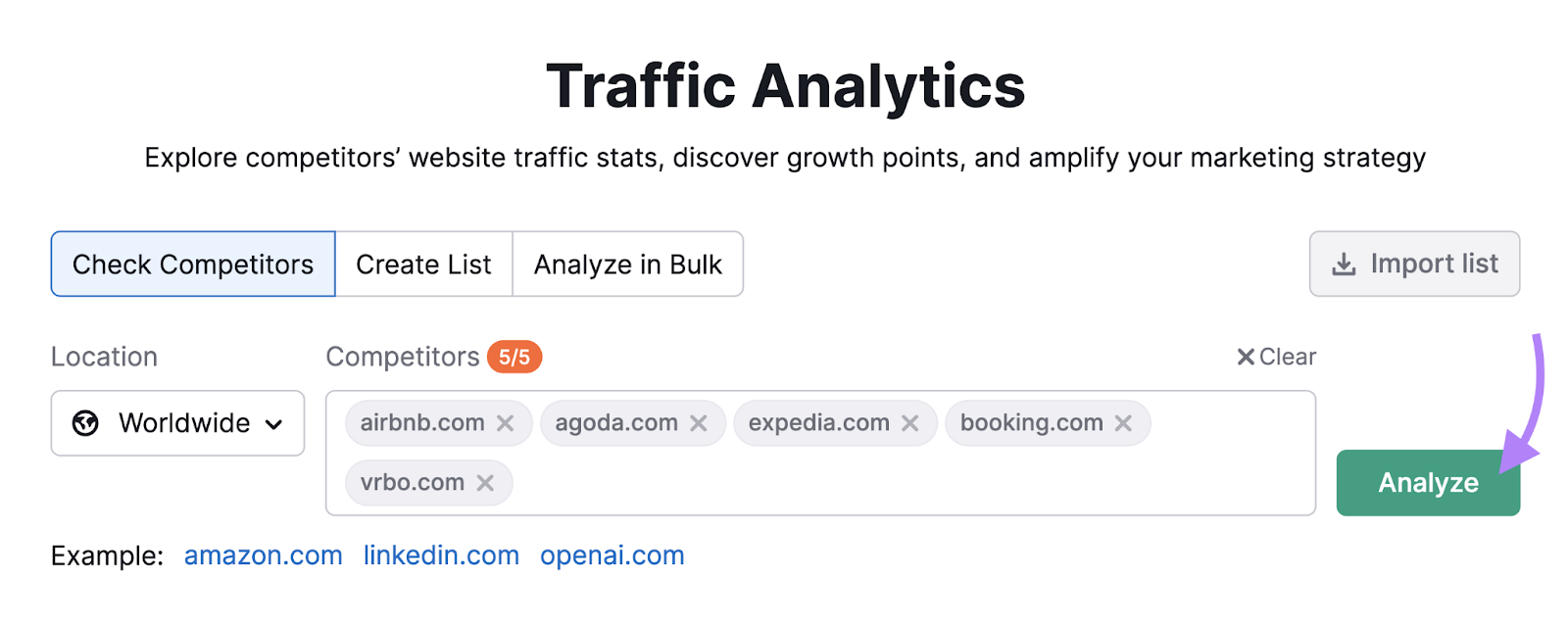
Go to the “Traffic Journey” tab to see a broad breakdown of the channels driving traffic to your competitors.
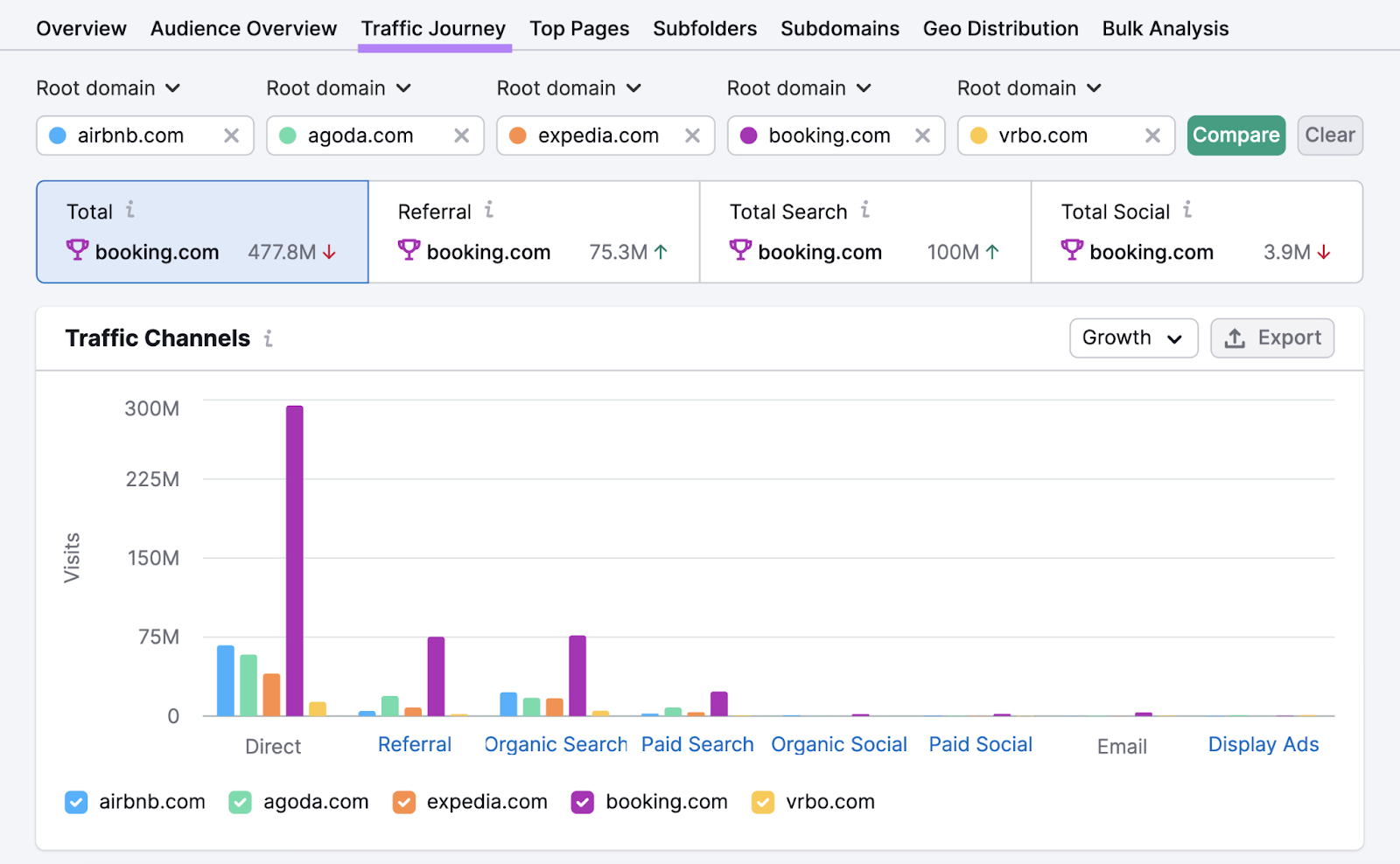
Next, scroll down to “Traffic Journey Details” to see specific traffic sources. .
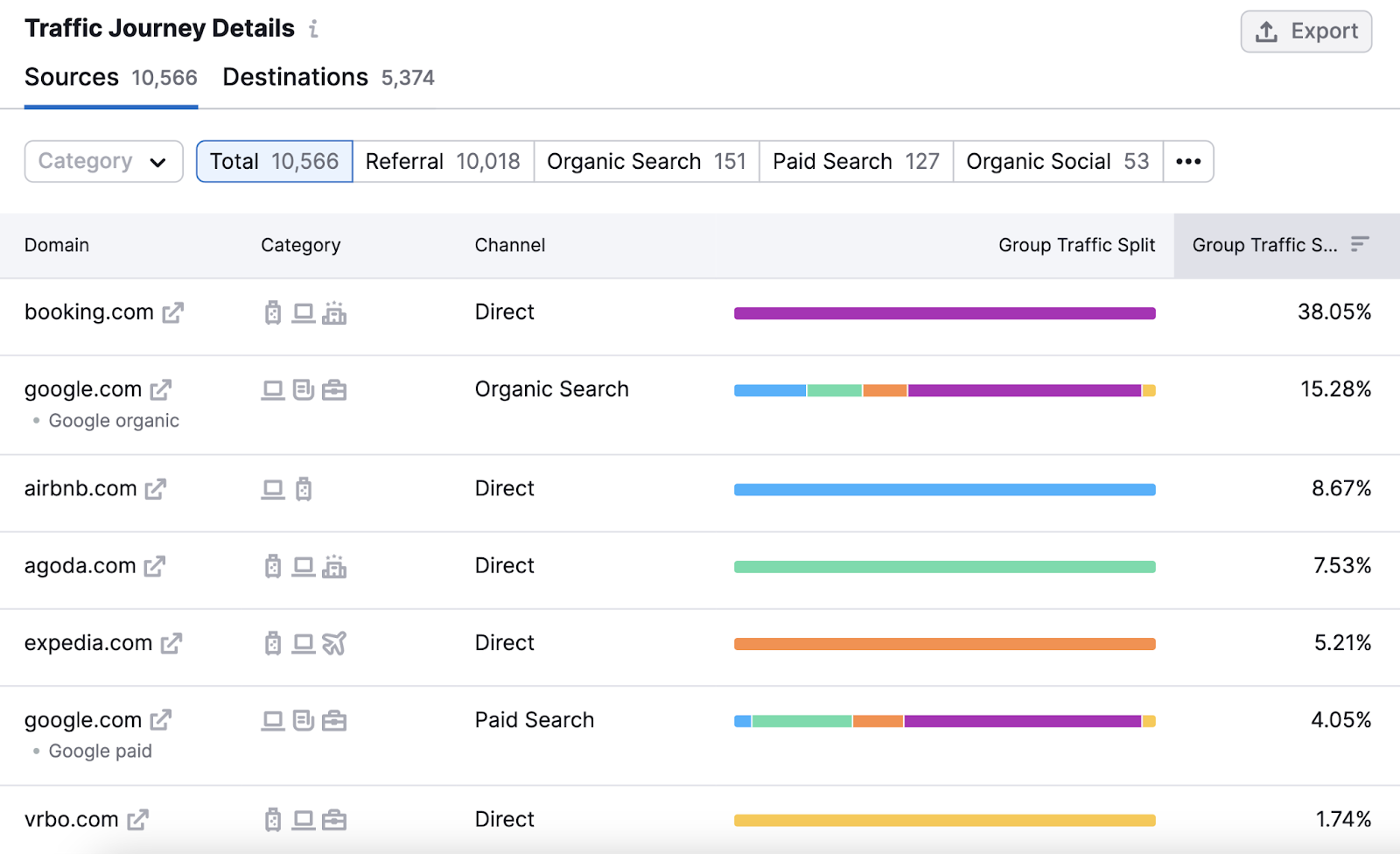
Let’s say you recognize that your competitors are receiving a considerable amount of traffic from Google paid search ads, which you aren’t leveraging. This is a good indication you could similarly benefit.
Real-Life Examples of Marketing Challenges That Brands Overcame
Launching New Products to Meet Changing Consumer Preferences
Starbucks always features its Pumpkin Spice Latte in the fall. But they also launch a series of other new products informed by customers.
One example is the Iced Pumpkin Cream Chai Tea Latte, which the company reports is inspired by a popular customer and barista combination.
This is a perfect example of how Starbucks is adapting to changing customer tastes. If it works well, Starbucks may re-release it in the coming years.
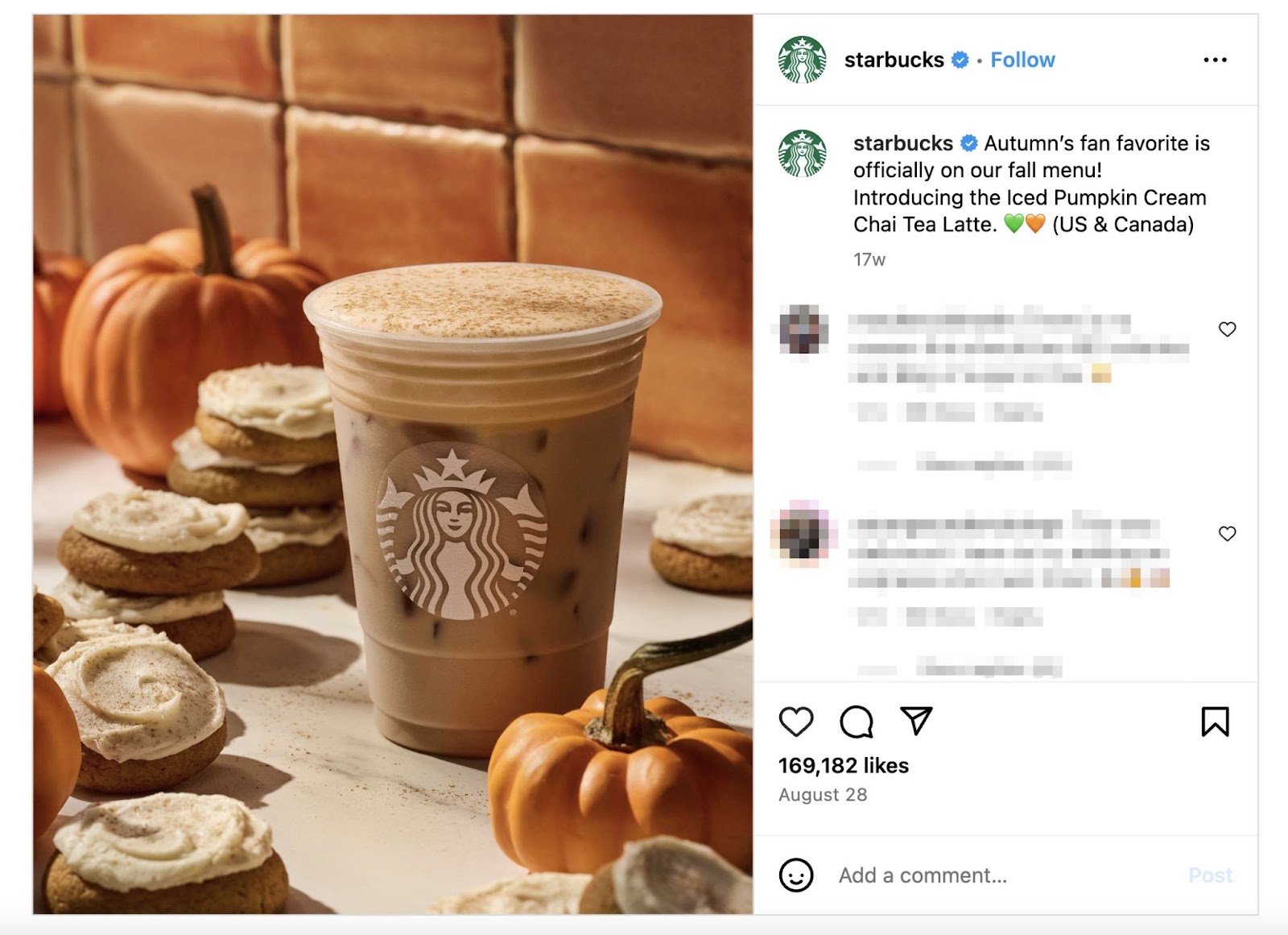
Recruiting Top Talent with an Unorthodox Method
Mark Kosoglow got creative when searching for top talent—something that’s becoming important given how many choices prospective employees have.
Instead of using a traditional job posting, Kosoglow posted a challenge on LinkedIn for a sales development representative (SDR) manager.
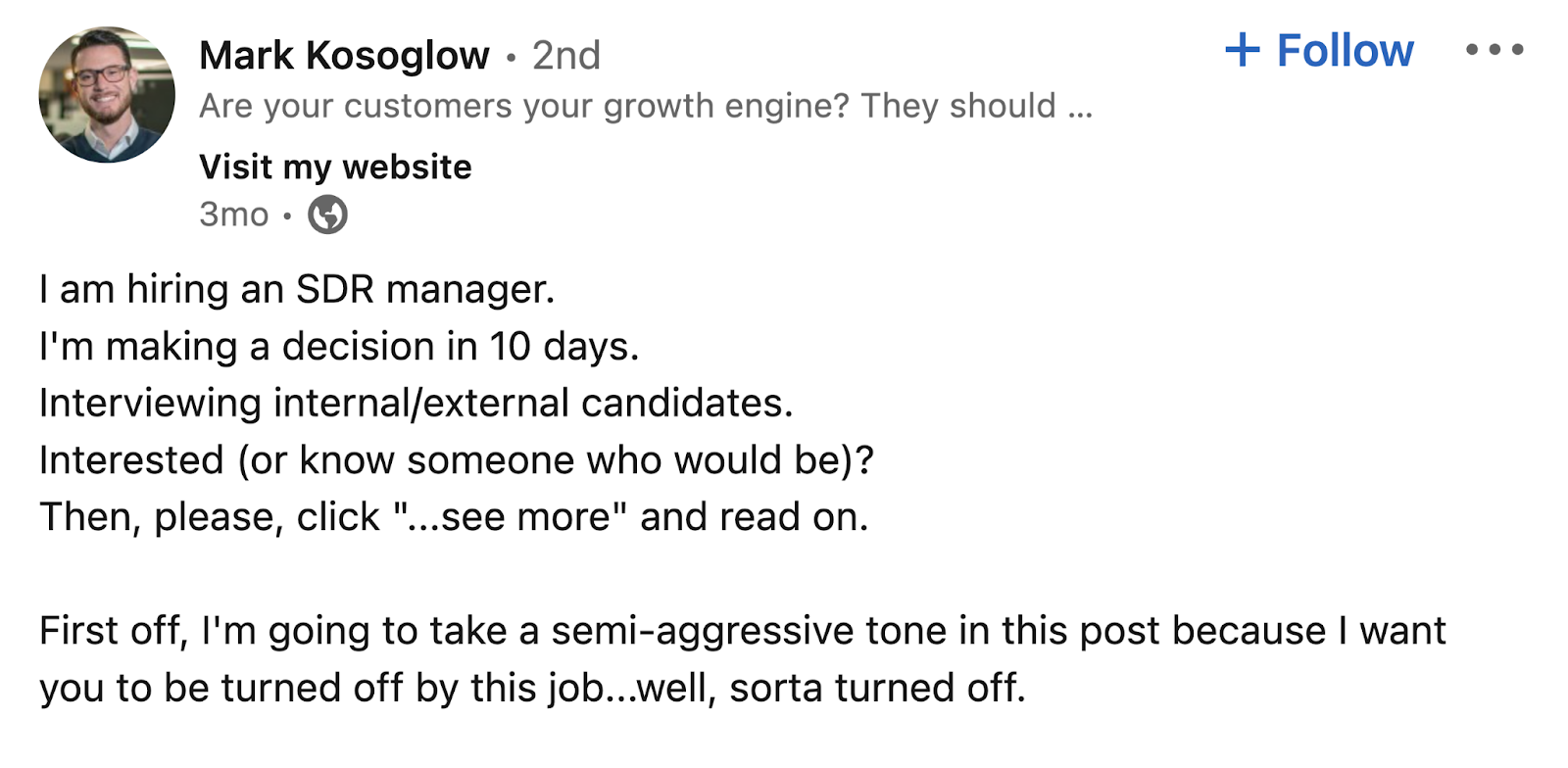
Anyone who could get his attention with something compelling would have a chance at an interview. And Kosoglow made the challenge compelling by setting the tone with edgy language that conveyed the type of person he was looking for.
And it seems to have worked. Kosoglow followed up shortly after in another post to mention he was able to book four interviews with great candidates.
Tackle Your Biggest Marketing Challenges
It’s likely at least one of these key marketing challenges is affecting your business. And you may be considering which solution you’re going to try first.
Regardless of your choice, using the right tools is essential to success.
With a Semrush subscription you’ll gain access to everything you need to solve your top marketing challenges.
Sign up for a free Semrush account to get going.
